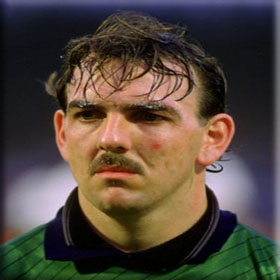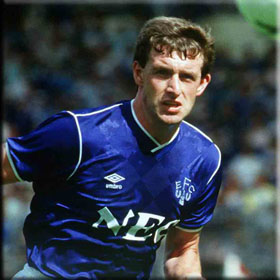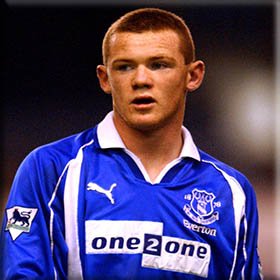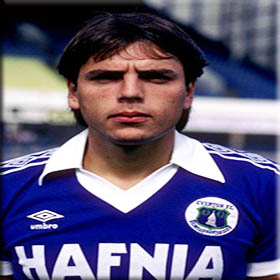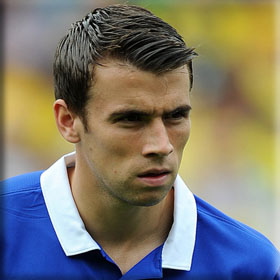Everton FC
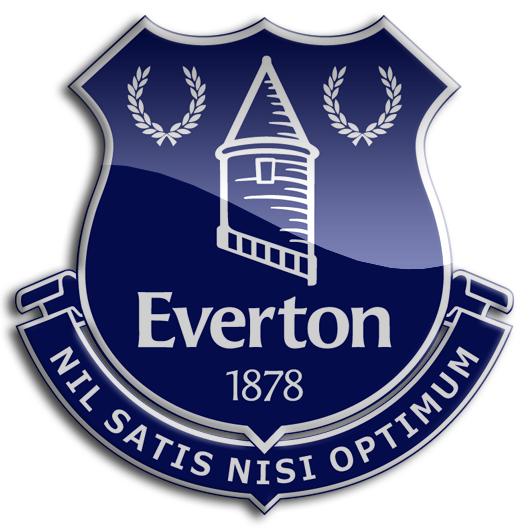
Details
- Name: Everton Football Club
- Nickname: The Toffees / Blues / Peoples Club / School of science
- Founded: 1878 (as St Domingo's FC
- Renamed: 1879 to Everton FC
- Ground: Goodison Park
- Ground capacity: 39,572
Goodison Park
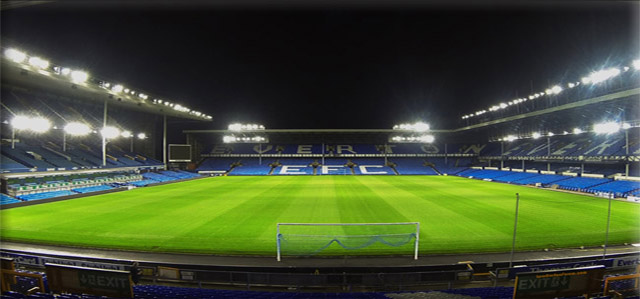
The History - Before Goodison Park
Everton originally played on an open pitch in the south-east corner of the newly laid out Stanley Park, which is the site for the proposed new Liverpool FC stadium.
The first official match took place in 1879.
In 1882, a Mr J. Cruit donated land at Priory Road with the necessary facilities required for professional clubs. Cruit asked the club to leave his land after two years because the crowds became far too large and noisy.
Everton moved to nearby Anfield, where proper covered stands were built. Everton played at Anfield from 1884 until 1892.
During this time the club turned professional and entered teams in the FA Cup. They became founding members of the Football League and won their first championship at the ground in 1890–91.
Anfield's capacity grew to over 20,000 and the club hosted an international match between England and Ireland. During their time at Anfield, Everton became the first club to introduce goalnets to professional football.
In the 1890s, a dispute about how the club was to be owned and run emerged with John Houlding, Anfield's majority owner and Everton's Chairman, at the forefront. Houlding and the club's committee initially disagreed about the full purchase of the land at Anfield from minor land owner Mr Orrell and escalated into a principled disagreement of how the club was run.
Two such disagreements included Houlding wanting Everton to sell only his brewery produce during an event and for the Everton players to use his public house The Sandon as changing room facilities.
The most famous of the disagreements concerns the level of increased rent Everton were asked to pay. In 1889, Everton paid £100 to Houlding in rent and by the 1889–90 season he was charging Everton £250. Everton had to pay for all work and stands. The dispute escalated to a rent of £370 per year being demanded.
In the complicated lead up to the split in the club, the rent dispute is too simplistic to be singled out as the prime cause. The dispute was compounded by many minor disputed points. The flashpoint was a covenant in the contract of land purchase by Houlding from Orrell causing further and deep friction. A strip of land at the Anfield ground bordering the adjacent land owned by Mr Orrell, could be used to provide a right of way access road for Orrell's landlocked vacant site.
In early 1891 the club erected a stand on this now proposed roadway, which was also overlapping Orrell's land, unbeknown to the Everton FC Committee. In August 1891 Orrell announced intentions of developing his land next to the football ground and building an access road on the land owned by Houlding and occupied by Everton FC.
Everton FC stated they knew nothing of the covenant, Houlding stated they did.
This situation created great distrust and friction between Houlding and the Everton FC Committee. The rift and distrust between the committee and Houlding was on three levels, Houlding's personal business intentions, politically and morally. Nevertheless, the club faced a dilemma of having to destroy the new revenue generating stand or compensate Orrell.
Houlding's way around the problem was to propose a limited company with floatation of the club enabling the club to purchase Houlding's and Orrell's land outright, hoping to raise £12,000.
Previous attempts to raise money from the community had failed miserably. This would have meant the club would need to find £6,000 in cash with an additional £4,875 mortgage.
The Everton Committee initially accepted Houlding's proposal in principle, yet voted against it at a meeting. After much negotiating and brinkmanship on both sides Everton vacated Anfield, leaving Houlding with an empty stadium and no one to play in it.
As a consequence, Houlding formed his own football club, Liverpool, to take up residence at the stadium.
The clubs themselves have differing versions of events of why it occurred:
Houlding explained why this situation arose in a match programme against Cliftonville in April 1893. He pointed out that he had given Everton a rent free loan until the club started to make money. If the club had gone bust he would have lost it all. Despite making no profit in this respect, the issue that upset the members at Everton most was his plan to sell Anfield and the land adjoining, with Houlding himself profiting. He felt it was a reasonable reward for the risk he had ventured in the club for nine years. Houlding, as the ambitious businessman he was, saw a great future for the club. He wanted the club to have its own home ground and wanted them to buy land so the club could expand in due course.
Unfortunately most of the Everton FC board members failed to share his forward thinking and lacked confidence. They wanted instead a long term rent deal on all the land, but for this to be acceptable to Houlding, he wanted a rent at a price considered too high for the Club. The members reacted to that by "offering" Houlding less rent. Houlding unsurprisingly refused to accept this stating that he did not want to be dictated: "I cannot understand why a gentleman that has done so much for the club (Everton) and its members should be given such treatment". — Liverpool FC version of events
During their spell at Anfield, John Houlding decided to charge the Club rent based on the increase of gate receipts from attendances and not, as was previously the case, at a fixed rate. "This – along with other conflicts with Everton – led to the Club being expelled from Anfield in 1892 and in need of a new home.... fully expecting Houlding to dismiss Everton from their Anfield home, he (George Mahon) acquired land on a patch off Stanley Park called 'Mere Green Field' and also made sure that the Club kept their name." — Everton FC version of events
Honours
- First Division:
- Champions: (9): 1890–91, 1914–15, 1927–28, 1931–32, 1938–39, 1962–63, 1969–70, 1984–85, 1986–87
- Runners-up: (7): 1889–90, 1894–95, 1901–02, 1904–05, 1908–09, 1911–12, 1985–86
- Second Division:
- Winners: (1): 1930–31
- Runners-up: (1): 1953–54
- FA Cup:
- Winners: (5): 1906, 1933, 1966, 1984, 1995
- Runners-up: (8): 1893, 1897, 1907, 1968, 1985, 1986, 1989, 2009
- Football League Cup:
- Runners-up: (2): 1977, 1984
- FA Charity Shield:
- Winners: (9): 1928, 1932, 1963, 1970, 1984, 1985, 1986 (shared), 1987, 1995
- Runners-up: (2)– 1933, 1966
- Full Members Cup:
- Runners-up: (2): 1989, 1991
- Super Cup:
- Runner-up: (1): 1985–86
- FA Youth Cup:
- Winners: (3): 1965, 1984, 1998
- Runners-up: (4): 1961, 1977, 1983, 2002
- Central League:
- Winners: (4): 1913–14, 1937–38, 1953–54, 1967–68
- Lancashire Senior Cup:
- Winners: (6): 1894, 1897, 1910, 1935, 1940, 1964
- Liverpool Senior Cup:
- Winners: (45): 1884, 1886, 1887, 1890, 1891, 1892, 1894, 1895, 1896, 1898, 1899,
1900, 1904, 1906, 1908, 1910 (shared), 1911, 1912 (shared), 1914, 1919, 1921,
1922, 1923, 1924, 1926, 1928, 1934 (shared), 1936 (shared),
1938, 1940, 1945, 1953, 1954, 1956, 1957, 1958 (shared),
1959, 1960, 1961, 1982 (shared), 1983, 1996, 2003, 2005, 2007 - European Cup Winners' Cup:
- Winners: (1): 1985
- International
- MLS All-Star Game:
- Winners: (1): 2009
Sean Dyche
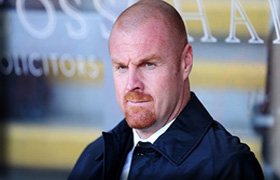
The Facts
Everton were founded as St Domingo's in 1878 so that people from the parish of St Domingo's Methodist Church in Everton could play sport year round —cricket was played in summer.
The club was renamed Everton a year later after the local area, as people outside the parish wished to participate.
The club was a founding member of The Football League in 1888–89, winning their first League Championship title in the 1890–91 season.
Everton won the FA Cup for the first time in 1906 and the League title again in 1914–15.
The outbreak of the First World War in 1914 interrupted the football programme while Everton were champions, something that would again occur in 1939.
It was not until 1927 that Everton's first sustained period of success began.
In 1925 the club signed Dixie Dean from Tranmere Rovers who, in 1927–28, set the record for league goals in a single season with 60 goals in 39 league games, a record that still stands to this day.
Dean helped Everton to achieve their third league title.
Everton were relegated to the Second Division two years later during internal turmoil at the club.
However, the club was promoted at the first attempt scoring a record number of goals in the second division.
On return to the top flight in 1931–32, Everton wasted no time in reaffirming their status and won a fourth League title at the first opportunity.
Everton also won their second FA Cup in 1933 with a 3–0 win against Manchester City in the final.
The era ended in 1938–39 with a fifth League title.
The outbreak of the Second World War again saw the suspension of League football, and when official competition resumed in 1946 the Everton team had been split and paled in comparison to the pre-war team.
Everton were relegated for the second time in 1950–51 and did not return until 1953–54, finishing as runners-up in their third season in the Second Division.
The club have been a top-flight presence ever since.
Everton's second successful era started when Harry Catterick was made manager in 1961.
In 1962–63, his second season in charge, Everton won the League title and in 1966 the FA Cup followed with a 3–2 win over Sheffield Wednesday.
Everton again reached the final in 1968, but this time were unable to overcome West Bromwich Albion at Wembley.
Two seasons later in 1969–70, Everton won the League championship, nine points clear of nearest rivals Leeds United.
During this period, Everton were the first English club to achieve five consecutive years in European competitions—seasons 1961–62 to 1966–67.
However, the success did not last; the team finished fourteenth, fifteenth, seventeenth and seventh in the following seasons.
Harry Catterick retired but his successors failed to win any silverware for the remainder of the 1970s.
Though the club mounted title challenges finishing fourth in 1974–75 under manager Billy Bingham, and under manager Gordon Lee, third in 1977–78 and fourth the following season. Gordon Lee was sacked in 1981.
Howard Kendall took over as manager and guided Everton to their most successful era.
Domestically, Everton won the FA Cup in 1984 and two league titles in 1984–85 and 1986–87 and the club's first and so far only European trophy securing the European Cup Winners' Cup in the 1985 final.
The European success came after first beating University College Dublin, Inter Bratislava and Fortuna Sittard, Everton defeated German giants Bayern Munich 3–1 in the semi-finals, despite trailing at half time (in a match voted the greatest in Goodison Park history) and recorded the same scoreline over Austrian club Rapid Vienna in the final.
Having won both the league and Cup Winners Cup in 1985, Everton came very close to winning a treble, but lost to Manchester United in the FA Cup final.
The following season, 1985–86, Everton were runners up to neighbours Liverpool in both the league and the FA Cup, but did recapture the league title in 1986–87.
After the Heysel Stadium disaster and the subsequent ban of all English clubs from continental football, Everton lost the chance to compete for more European trophies.
A large proportion of the title-winning side was broken up following the ban.
Kendall himself moved to Athletic Bilbao after the 1987 title triumph and was succeeded by assistant Colin Harvey.
Harvey took Everton to the 1989 final, but lost 3–2 after Extra time to Liverpool.
Everton were founder members of the Premier League in 1992, but struggled to find the right manager.
Howard Kendall had returned in 1990 but could not repeat his previous success, while his successor, Mike Walker, was statistically the least successful Everton manager to date.
When former Everton player Joe Royle took over in 1994 the club's form started to improve; his first game in charge was a 2–0 victory over derby rivals Liverpool.
Royle dragged Everton clear of relegation, leading the club to the FA Cup for the fifth time in its history, defeating Manchester United 1–0 in the final.
The cup triumph was also Everton's passport to the Cup Winners' Cup—their first European campaign in the post-Heysel era.
Progress under Joe Royle continued in 1995–96 as they climbed to sixth place in the Premiership.
A fifteenth place finish the following season saw Royle resign towards the end of the campaign, to be temporarily replaced by club captain, Dave Watson.
Howard Kendall was appointed Everton manager for the third time in 1997, but the appointment proved unsuccessful as Everton finished seventeenth in the Premiership; only avoiding relegation due to their superior goal difference over Bolton Wanderers.
Former Rangers manager Walter Smith then took over from Kendall in the summer of 1998 but only managed three successive finishes in the bottom half of the table.
The Everton board finally ran out of patience with Smith and he was sacked in March 2002 after an FA Cup exit at Middlesbrough, with Everton in real danger of relegation.
David Moyes, was his replacement and guided Everton to a safe finish in fifteenth place.
In 2002–03 Everton finished seventh, their highest finish since 1996.
A fourth place finish in 2004–05, ensured Everton qualified for the Champions League qualifying round.
The team failed to make it through to the Champions League group stage and were then eliminated from the UEFA Cup.
Everton qualified for the 2007–08 and 2008–09 UEFA Cup competitions and they were runners-up in the 2009 FA Cup Final.
Moyes broke the club record for highest transfer fee paid on four occasions, signing James Beattie for £6 million in January 2005, Andy Johnson for £8.6 million in summer 2006, Yakubu for £11.25 million in summer 2007, and Marouane Fellaini for £15 million in September 2008.
It was under David Moyes's management that Wayne Rooney broke into the first team, before being sold to Manchester United for a club record fee of £28 million.
At the end of the 2012–13 season David Moyes left his position at Everton to take over at Manchester United.
He was replaced by Roberto Martínez, who led Everton to 5th place in the league in his first season, amassing the club's best points tally for 27 years.
On Thursday 12th May 2016, Everton announced that Martinez' position as First Team Coach had ended.
See our History section below to see what happened next.
For further information check out our Official website.
Bill Kenwright 1945 - 2023
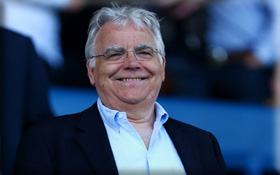
Genesis of Goodison Park
On 15 September 1891, a general meeting took place at Royal Street Hall, near Everton Valley.
 John Houlding proposed that a limited company be formed and that the company should purchase his land and local brewer Joseph Orrel's land for a combined £9,237. A club run as a limited company was unusual for the time as football clubs were usually run as “sports clubs” with members paying an annual fee. The proposal was supported by William Barclay, the club secretary and a close friend of Houlding.
John Houlding proposed that a limited company be formed and that the company should purchase his land and local brewer Joseph Orrel's land for a combined £9,237. A club run as a limited company was unusual for the time as football clubs were usually run as “sports clubs” with members paying an annual fee. The proposal was supported by William Barclay, the club secretary and a close friend of Houlding.
Liberal Party politician and Everton board member George Mahon fought the proposal and put forward his own amendment which was carried by the Everton board. At the time Everton's board contained both Conservative and Liberal Party councillors. Houlding and Mahon had previously clashed during local elections.
Both men agreed that Everton should operate as an limited company; however, they had different ideas about share ownership. Houlding suggested that 12,000 shares be created with each Everton board member given one share and the other shares sold to the public or Everton board members. Mahon disagreed and proposed that 500 shares be created with no member carrying more than 10 shares and board members being given "7 or 8" shares.
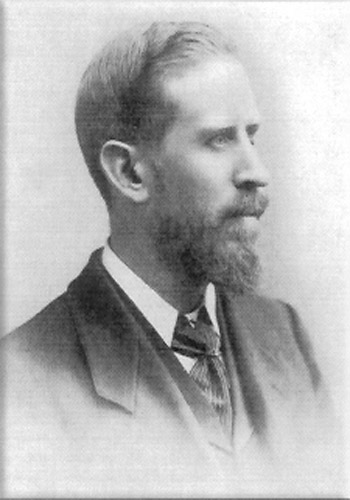 Mahon reasoned "we would rather have a large number of individual applications so that there will be more supporters of the club." A special general meeting was convened at the former Liverpool College building on Shaw Street on 25 January 1892. John Houlding's proposal was defeated once more and George Mahon suggested that Everton relocate to another site. A heckler shouted, "You can't find one!" Mahon responded "I have one in my pocket" and he revealed an option to lease Mere Green field, in Walton, Lancashire, the site of what is today known as Goodison Park.
Mahon reasoned "we would rather have a large number of individual applications so that there will be more supporters of the club." A special general meeting was convened at the former Liverpool College building on Shaw Street on 25 January 1892. John Houlding's proposal was defeated once more and George Mahon suggested that Everton relocate to another site. A heckler shouted, "You can't find one!" Mahon responded "I have one in my pocket" and he revealed an option to lease Mere Green field, in Walton, Lancashire, the site of what is today known as Goodison Park.
The Liverpool press were partisan.
The proposal was deemed to be a positive move for the club by the Liberal-leaning Liverpool Daily Post which described Houlding's ousting as "having shaken off the incubus." The Tory-supporting Liverpool Courier and Liverpool Evening Express—owned by Conservative MP for Everton, John A. Willox, a Trustee of the Licensed Victuallers’ and Brewers’ Association—took Houlding's side. The Courier published letters regularly criticising Mahon's supporters—many of which were anonymous. Philanthropist William Hartley, a jam manufacturer and Robert William Hudson, a prominent soap-manufacturer supported Mahon.
The stadium was named Goodison Park because the length of it was built against Goodison Road. The road was named after a civil engineer called George Goodison who provided a sewage report to the Walton Local Board in the mid-1800s and later became a local land owner.
The Mere Green field was owned by Christopher Leyland and Everton rented it until they were in a position to buy it outright. Initially, the field needed work as parts of the site had to be excavated, the field was levelled, a drainage system was installed and turf was laid. This work was considered to be a 'formidable initial expenditure' and a local contractor Mr Barton was contracted to work on the 29,471 square yards (25,000 m2) site at 4½d per square yard — a total cost of £552. A J. Prescott was brought in as an architectural advisor and surveyor.
Walton-based building firm Kelly brothers were instructed to erect two uncovered stands that could each accommodate 4,000 spectators. A third covered stand accommodating 3,000 spectators was also requested. The combined cost of these stands was £1,640 and Everton inserted a penalty clause into the contract in case the work was not completed by its 31 July deadline. Everton officials were impressed with the builder's workmanship and agreed two further contracts: exterior hoardings were constructed at a cost of £150 and 12 turnstiles were installed at a cost of £7 each. In 1894, Benjamin Kelly of Kelly Brothers was appointed as a director of Everton.
Dr. James Baxter of the Everton committee donated a £1,000 interest-free loan to build Goodison Park. The stadium was England's first purpose-built football ground, with stands on three sides. Goodison Park was officially opened on 24 August 1892 by Lord Kinnaird and Frederick Wall of the Football Association. No football was played; instead the 12,000 crowd watched a short athletics event followed by music and a fireworks display. Upon its completion the stadium was the first joint purpose-built football stadium in the world; Celtic's Celtic Park ground in Scotland was inaugurated on the same day as Goodison.
The first match at Goodison Park was on 2 September 1892 between Everton and Bolton Wanderers. Everton wore its new club colours of salmon and dark blue stripes and won the exhibition game 4–2. The first league game at Goodison Park took place on 3 September 1892 against Nottingham Forest; the game ended in a 2–2 draw. The stadium's first competitive goal was scored by Forest’s Horace Pike and the first Everton goal came from Fred Geary. Everton's first league victory at their new ground came in the next home game with a 6–0 defeat of Newton Heath in front of an estimated 10,000 spectators.
It was announced at a general meeting on 22 March 1895 that the club could finally afford to buy Goodison Park.
Mahon revealed that Everton were buying Goodison Park for £650 less than the price of Anfield three years earlier, and Goodison Park had more land and had 25% larger capacity.
The motion to purchase Goodison Park was passed unanimously. Dr. Baxter also lent the club £5,000 to pay the mortgage early at a rate of 3½%. By this time the redrawing of political boundaries meant that Walton, and hence Goodison Park, were within the City of Liverpool.
In 1999, The Independent newspaper journalist David Conn unexpectedly coined the nickname "The Grand Old Lady" for the stadium when he wrote "Another potential suitor has apparently thought better of Everton, walking away on Tuesday from the sagging Grand Old Lady of English football, leaving her still in desperate need of a makeover.
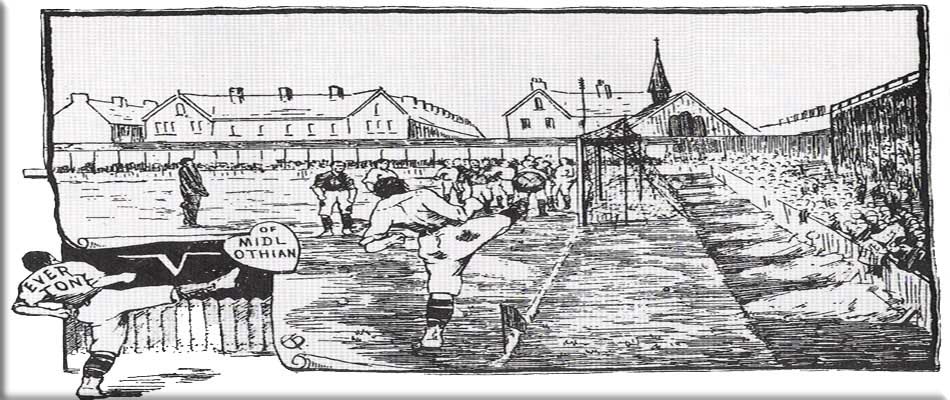
Structural developments
The Goodison Park structure was built in stages.
In the summer of 1895 a new Bullens Road stand was built and a roof placed on the original Goodison Road stand but only after five directors, including Chairman, George Mahon had resigned over what was described in the club minutes as 'acute administrative difficulties'. In 1906, the doubled-decker Goodison Avenue Stand was built behind the goal at the south end of the ground. The stand was designed by Liverpool architect Henry Hartley who went on to chair the Liverpool Architectural Society a year later. The club minutes from the time show that Hartley was unhappy with certain aspects of the stand and the poor sight lines meant that the goal line had to be moved seven metres north, towards Gwladys Street. In January 1908, he complained that his fees had not been paid and the bill for the stand was near £13,000. There were 2,657 seats on its upper tier with a terrace below.
Archibald Leitch designed the Goodison Road Stand with construction in 1909.
In September that year Ernest Edwards, the Liverpool Echo journalist who christened the terrace at Anfield the "Spion Kop", wrote of the newly built stand, "The building as one looks at it, suggests the side of Mauretania at once."
The stand was occasionally referred to as the "Mauretania Stand", in reference to the Liverpool-registered RMS Mauretania, then the world's largest ship, which operated from the Port of Liverpool.
The two-tier steel frame and wooden floor Bullens Road Stand, designed by Archibald Leitch, was completed in 1926. The upper tier was seated, with terracing below, a part of the ground called The Paddock. Few changes were made until 1963 when the rear of the Paddock was seated and an overhanging roof was added. The stand is known for Archibald Leitch's highly distinctive balcony trusses which also act as handrails for the front row of seats in the Upper Bullens stand. Goodison Park is the only stadium with two complete trusses designed by Leitch. Of the 17 created, only Goodison Park, Ibrox and Fratton Park retain these trusses.
Everton constructed covered dugouts in 1931.
The idea was inspired by a visit to Pittodrie to play a friendly against Aberdeen, where such dugouts had been constructed at the behest of the Dons' trainer Donald Colman.
The Goodison Park dugouts were the first in England.
The ground become an entirely two-tiered affair in 1938 with another Archibald Leitch stand at the Gwladys Street end. The stand completed at a cost of £50,000, being delayed because an old man would not move from his to be demolished home. Architect Leitch and Everton Chairman Will Cuff became close friends with Cuff appointed as Leitch's accountant with Leitch moving to nearby Formby.
In 1940, during the Second World War, the Gwladys Street Stand suffered bomb damage.
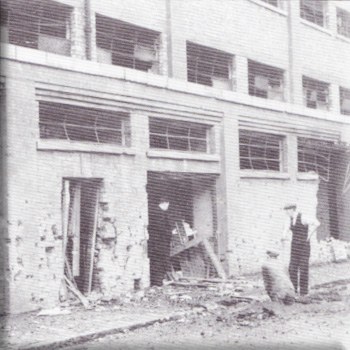 The bomb had landed directly in Gwladys Street and caused serious injury to nearby residents. The bomb splinter damage to the bricks on the stand is still noticeable. The cost of repair was £5,000 and was paid for by the War Damage Commission. The Director's minutes read: "It was decided also that Messrs A. Leitch be instructed to value the cost of complete renewal of damaged properties and that a claim should be forwarded to the War Damage Claims department within the prescribed 30 days."
The damage referred to included the demolition of a wide section of the new stand outer wall in Gwladys St, destruction of all glass in this stand, damage to every door, canteen, water and electricity pipe and all lead fittings: perforate roof in hundreds of places.
The bomb had landed directly in Gwladys Street and caused serious injury to nearby residents. The bomb splinter damage to the bricks on the stand is still noticeable. The cost of repair was £5,000 and was paid for by the War Damage Commission. The Director's minutes read: "It was decided also that Messrs A. Leitch be instructed to value the cost of complete renewal of damaged properties and that a claim should be forwarded to the War Damage Claims department within the prescribed 30 days."
The damage referred to included the demolition of a wide section of the new stand outer wall in Gwladys St, destruction of all glass in this stand, damage to every door, canteen, water and electricity pipe and all lead fittings: perforate roof in hundreds of places.
"On Bullens Road side, a bomb dropped in the school yard had badly damaged the exterior wall of this stand and the roof was badly perforated here also. A third bomb outside the practice ground had demolished the surrounding hoarding and had badly damaged glass in the Goodison Ave and Walton Lane property."
The first floodlit match at Goodison Park took place when Everton hosted Liverpool on 9 October 1957 in front of 58,771 spectators.
Four pylons 185 feet (56 m) each with 36 lamps installed were installed behind each corner of the pitch, at the time they were tallest in the country. There was capacity for 18 more lamps per pylon if it was felt the brightness was insufficient for the game. Each bulb was a 1,500 watt tungsten bulb 15 inches in diameter and cost 25 shillings. It was recommended that the club made a habit of changing them after three to four seasons to save the club performing intermittent repairs. Manweb installed a transformer sub-station to cope with the 6,000 volt-load.
The first undersoil heating system in English football was installed at Goodison Park in 1958, with 20 miles (30 km) of electric wire laid beneath the playing surface at a cost of £16,000.
The system was more effective than anticipated and the drainage system could not cope with the quantity of water produced from the melting of frost and snow. As a consequence the pitch had to be relaid in 1960 to allow a more suitable drainage system to be installed.
The Everton chairman Sir John Moores who presided over the club between 1960 and 1973 provided finances for the club in the form of loans to become involved in large-scale redevelopment projects and compete with other clubs for the best players, for a period of time under his stewardship Everton were known as 'The Mersey Millionaires'.
Goodison Park featured in the filming of The Golden Vision, a BBC film made for television.
The matches featured in the film were Division One games against Manchester City on 4 November 1967 (1–1 draw) and 18 November 1967 versus Sheffield United (1–0 win) - the scorer of the winner that day was Alex Young, also known as The Golden Vision or Golden Ghost after whom the film was named.
Everton were the first club to have a scoreboard installed in England.
On 20 November 1971 Everton beat Southampton 8–0 with Joe Royle scoring four, David Johnson three and Alan Ball one. The scoreboard did not have enough room to display the goal scorer's names and simply read "7 9 7 9 8 9 9 7" as it displayed the goal scorers' shirt numbers instead.
The Goodison Road Stand was partially demolished and rebuilt during the 1969–70 season with striking images of both old and new stands side by side. The new stand opened 1971, at a cost of £1 million. The new stand housed the 500 and 300 members clubs and an escalator to the tallest stand in the ground—the Top Balcony. However, not everyone thought that the upgrade was necessary at the time. Journalist Geoffrey Green of The Times wrote:
"Goodison Park has always been a handsome fashionable stage for football, a living thing full of atmospherics-like a theatre. And now it has stepped into the demanding seventies with a facelift it scarcely seemed to need compared with some of us I know. New giant stands in place of the old; the latest in dazzling floodlight systems that cast not a shadow. A cathedral of a place indeed, fit for the gods of the game."
The "Safety of Sports Grounds Act 1975" saw the Bullens Road Stand extensively fireproofed with widened aisles, which entailed closure of parts of the stand. Because of the closure, Anfield was chosen over first choice Goodison Park for a Wales vs Scotland World Cup qualifying tie. Following Moores' exit from Everton's hierarchy, minimum changes have been made to Goodison Park's structure due to costs, two British Government Acts; the Safety of Sports Grounds Act 1975 and Football Spectators Act 1989 have forced the club's hand into improving the facilities. Upon Moore's death the club was sold to Peter Johnson.
Everton legends William Ralph 'Dixie' Dean and former manager Harry Catterick both died at Goodison Park. Dean suffered from a heart attack aged 73 in 1980, whilst Catterick died five years later, also suffering a heart attack aged 65. Everton FC celebrated the centenary of Goodison Park with a game against German club side Borussia Mönchengladbach in August 1992. In addition, 200 limited edition medals were created and Liverpool based author and journalist Ken Rogers wrote a book One Hundred Years of Goodison Glory to commemorate the occasion.
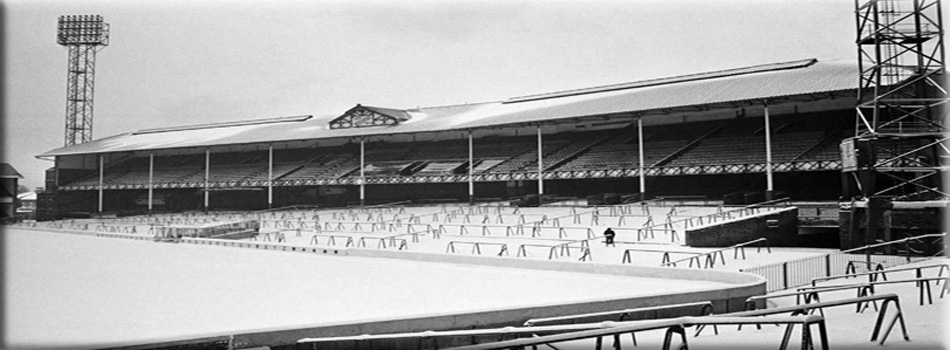
Post-Taylor Report
Following the publication of the 1990 Taylor Report, in the wake of the Hillsborough disaster, top-flight English football grounds had to become all-seated. At the time three of the four sides of the ground had standing areas. The Enclosure, fronting the main stand, had already been made all-seated in time for the 1987–88 season and was given the new name of Family Enclosure. The Paddock, the Park End terrace and the Gwladys Street terrace, known as 'the Ground', were standing and had to be replaced. The fences around the perimeter of the ground fronting the terracing (which were to prevent fans, notably hooligans, running onto the pitch) were removed immediately post Hillsborough, in time for the rearranged league fixture with Liverpool. The Everton match versus Luton Town in May 1991 was the final time that Gwladys Street allowed standing spectators. Seats were installed in the Paddock, while the Lower Gwladys Street was later completely rebuilt to accommodate seating with new concrete steps.
Everton opted to demolish the entire Park End stand in 1994 and replace it with a single-tier cantilever stand, with the assistance of a grant of £1.3 million from the Football Trust.
The stands
Goodison Road Stand
Built in sections from 1969 to 1971, replacing the large double-decker 1909 Archibald Leitch designed stand. The Goodison Road Stand is a double-decker stand with the lower deck being two-tier. Each level is given a separate name. The middle-deck level is known as the Main Stand and is fronted by another seated section known as the Family Enclosure. The Enclosure was originally terracing prior to the advent of all-seater stadia. The Top Balcony is the highest part of the stadium. The stand became all seated in 1987 and now has a capacity of 12,664.
The back wall of the stand cuts into the stand because of the non-square nature of the Goodison Park site. The Goodison Road Stand is also home to the conference and hospitality facilities. On non-match days Goodison Park holds conferences, weddings, meetings and parties on a daily basis.
Bullens Road
On the east side of the ground, the Bullens Road stand is divided into the Upper Bullens, Lower Bullens and The Paddock. The rear of the south end of the stand houses away supporters. The north corner of the stand is connected to the Gwladys Street Stand. The current capacity of the stand is 10,546. The stand takes its name from the adjacent Bullens Road. The Upper Bullens is decorated with Archibald Leitch's distinctive truss design.
Gwladys Street Stand
Behind the goal at the north end of Goodison Park, the Gwladys Street Stand is divided into Upper Gwladys and Lower Gwladys. This stand is the "Popular End", holding the most boisterous and vociferous home supporters. It is known colloquially as "The Street End". If Everton win the toss before kick-off the captain traditionally elects to play towards the Gwladys Street End in the second half. One of the traditions of the stand is also to applaud the visiting goalkeeper as he runs out to the goal of the stand. The stand has a capacity of 10,611 and gives its name to Gwladys Street’s Hall of Fame.
The Park End
At the south end of the ground, behind one goal, the Park End Stand backs onto Walton Lane which borders Stanley Park. The name of the stand was originally the Stanley Park End but it's commonly referred to as the Park End. The single tiered stand broke from the multi-tiered tradition of Goodison Park. The Park End has the smallest capacity at Goodison Park. The current layout of the stand was opened on 17 September 1994 with a capacity of 5,750. It was opened by David Hunt, a Member of Parliament. During the structure's development, fans were able to watch matches by climbing trees in neighbouring Stanley Park.
In the late 1970s and 1980s the stand accommodated the away fans. Previously it was open to home supporters. The lower tier of the old stand was terracing and this was closed off by the turn of the 1980s due to it being a fire hazard as the terracing steps were wooden. The front concrete terracing remained and was one of the last standing areas at a Premiership ground. During the 1960s and 1970s, both ends of the ground featured a large arc behind the goals. This was created as a requirement for the 1966 World Cup because the crowd had to be a required distance from the goals.
The area around Goodison Park when built was a dense area full of terraced housing, and Goodison Avenue behind the Park End stand was no different. Oddly housing was built right into the stand itself (as shown on old photographs of Goodison and in programmes). The club had previously owned many of the houses on the road and rented them to players. One of the players to live there, Dixie Dean later had a statue erected in his honour near the Park End on Walton Lane.By the 1990s the club had demolished virtually the whole street and this coincided with the redevelopment of the Park End stand. However at present the majority of the land is now an open car park for the club and its Marquee.
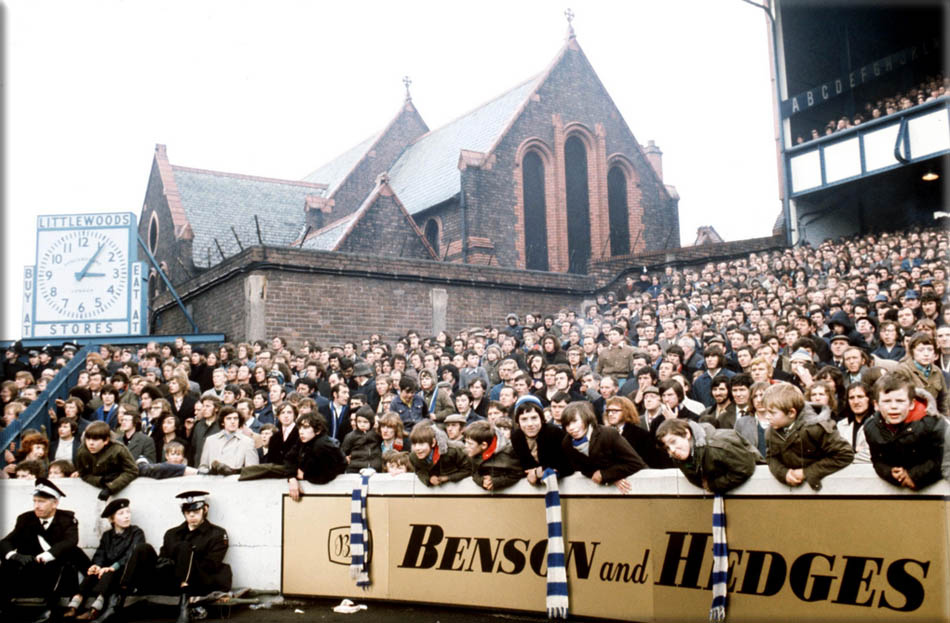
St Luke's Church
Goodison Park is unique in the sense that a church, St Luke's, protrudes into the site between the Goodison Road Stand and the Gwladys Street Stand only yards from the corner flag. Everton do not play early kick-offs on Sundays in order to permit Sunday services at the church.The church is synonymous with the football club and a wooden church structure was in place when Goodison Park was originally built. Former Everton players such as Brian Harris have had their funeral service held there.
The church can be seen from the Park End and Bullens Road and has featured prominently over the years as a backdrop during live televised matches. It is also the home to the Everton Former Players' Foundation of which the Reverend is a trustee. The church has over the years curtailed development of the ground. Everton did attempt to pay for its removal in order to gain extra space for a larger capacity. One of two jumbotron screens (both installed in 2000) has been installed between the Goodison Road stand and Gwladys Street stand partially obscuring the church from view. The other is situated between the Bullens Road and Park End.
Imaginative spectators would climb the church and watch a football game from the rooftop however they have now been deterred from doing so with the installation of security measures such as barbed wire and anti-climb paint. In addition, the introduction of the 'all-seater' ruling following the Taylor Report has meant that spectators no longer resort to climbing nearby buildings for a glimpse of the event as a seat is guaranteed with a purchased ticket.
History
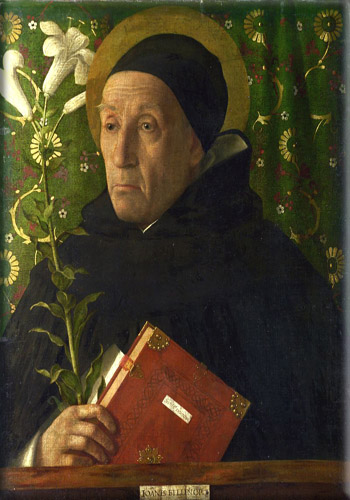
1878 foundation
St. Domingo Methodist New Connexion Chapel was opened in 1871 in Breckfield Road North, Everton, Liverpool. The chapel took its name from St. Domingo Road, formerly St. Domingo Lane, Everton which in turn took its name from St. Domingo House, a building built in 1758 by West Indies trader and sugar boiler George Campbell who would frequent the Colony of Santo Domingo and later became Mayor of Liverpool (1763). St. Domingo House was named after the Spanish Colony which in turn was named after Saint Dominic. Six years later, Rev. Ben Swift Chambers was appointed Minister. He created a cricket team for the youngsters in the area but, as cricket was only played in summer, there was room for another sport during winter. Thus a football club called St. Domingo F.C. was formed in 1878.
Many people not attending the chapel were interested in joining the football club so it was decided that the name should be changed. In November 1879 at a meeting in the Queen's Head Hotel, the team name was changed to Everton Football Club, after the surrounding area. Barker and Dobson, a local sweet manufacturer, introduced "Everton Mints" to honour the club. The district is also the location of the team's crest image, Everton Village Lock-up locally nicknamed Prince Rupert's Tower.
Everton originally played on an open pitch in the southeast corner of the newly laid out Stanley Park, the same site for the once proposed new Liverpool F.C. stadium. The first official match under the name Everton F.C. took place in 1879 against St. Peters with a 5-0 win. John Houlding's house backed onto the park and was attracted to the club that attracted large crowds.
Professional clubs required proper enclosed facilities. In 1882, a Mr J. Cruit donated land at Priory Road which became the club's home for two years, with proper hoarding and turnstiles. Mr Cruit asked the club to leave his land as the crowds became far too large and noisy. Everton moved to nearby Anfield in 1884, renting from John Orrell, a friend of Houlding. Proper covered stands were built. Houlding bought Anfield one year after Everton moved in, Everton initially making a donation to a local hospital in lieu of rent before paying rent to their own president.
Within seven years of moving to Anfield the club had converted the ground from a brick field to a 20,000 plus international standard ground with accommodation on all sides. The club rose from amateur to professional, hosting an international match, England vs. Ireland, founder members of the Football League and winning their first title. The club's income rose substantially.
Football League founders
In 1888 Everton became founder members of the Football League, finishing eighth the first season and second the following.
First League title
The 1890–91 season started in superb form with five straight victories, with Fred Geary scoring in each of the first six matches. By mid-January, Everton had completed all but one of their fixtures and were on 29 points, while Preston North End were eleven points adrift with seven games still to play. Everton than had to sit out the next two months as Preston completed their fixture list until they were only two points adrift with one match each left to play. Both teams played their final games of the season on 14 March, with Everton losing 3–2 at Burnley (Geary scored both Everton goals) and Preston going down 3–0 at Sunderland. Everton were thus able to win the Football League Championship for the first time, by a margin of two points with fourteen victories from their 22 league games. Geary had been ever-present, and was the club's top goal-scorer with 21 goals.
Move to Goodison Park
After winning the league for the first time, the Everton Committee and President John Houlding became embroiled in deep and bitter conflict. Houlding originally rented Anfield from the Orrell family and sublet to Everton FC. In 1885 Houlding bought the land from Orrel and rented directly to Everton FC. The Liberal-leaning committee viewed Tory councillor Houlding as having a personal financial and political agenda and there was disagreement over the club's business model and the issue of selling refreshments, to which Houlding had sole rights. Houlding had increased the club's rent by 150% after the 1889–90 season to £250 per annum. John Orrell, who owned the adjacent land, then attempted to legally run a road through the new main stand to access his land. This would require Everton to buy both Anfield and Orrell's land or to rent both. Everton committee members accused Houlding of knowing of the legal right of way and allowing the new stand to be built. The committee wanted Houlding to negotiate on the combined Anfield and Orrell's land rent of £370 or the purchase of both, but were told the rental fee was non-negotiable. Houlding refused to give Everton FC a contractual rental lease.
Houlding attempted to hijack the club by registering another company, Everton F.C. and Athletic Grounds, Ltd.in March 1892. Everton were still occupying and playing at Anfield, Houlding sought to take over Everton's fixtures and position in the Football League. The Football Council[clarification needed] would not recognise Houlding's new company as Everton, resulting in his changing the name to Liverpool F.C. and Athletic Grounds Ltd in June 1892, creating Liverpool F.C.. The distrust between Houlding and the Everton Committee resulted in Everton abandoning their substantial ground at Anfield and moving to Goodison Park on the north side of Stanley Park, issuing 5,000 shares as they did so, giving the directors a 6% stake in the club. Everton played their last match at Anfield on 18 April 1892 vs. Bolton Wanderers

FA Cup
Following the move to Goodison Park Everton reached four FA Cup finals before the First World War, losing 1-0 against Wolverhampton Wanderers at Fallowfield Stadium on 26 March 1893 and 3-2 against Aston Villa at Crystal Palace on 10 April 1897 before winning at their third attempt on 20 April 1906 against Newcastle United again at Crystal Palace.
Everton then reached their second successive final on 20 April 1907, however, finished in a 2-1 defeat by Sheffield Wednesday.
Champions again
1914–15 was to be the final season before league football was suspended for the duration of World War I. Everton won their second league title, one point ahead of Oldham Athletic.
Interwar years: Dean and co.
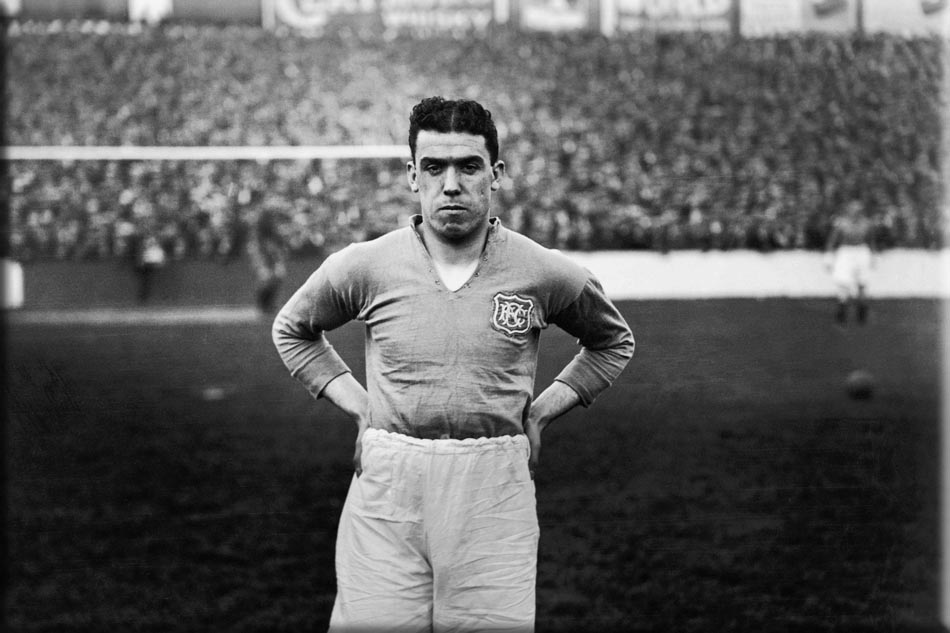
William Ralph Dean, better known as "Dixie" Dean, was one of the greatest goal scorers that the English game has seen. After averaging a goal a match for Tranmere Rovers, prolific striker Dean was lured across the River Mersey to play for Everton. In his first season for Everton, the 1925–26 season, Dean netted 32 league goals in 38 matches, scoring his first two on his debut. The next season he scored 21 goals in 27 matches.
Sixty
Making history in 1927–28, Dean scored 60 league goals in 39 matches, setting a record that has stood ever since and almost single-handedly gave Everton the league title.
In a bizarre turn of events, in 1930 Everton finished last in the first division being relegated to the second division. Dean was on top form in the secondary league, scoring 39 goals in 37 matches and lifting Everton to promotion at the first attempt as the Second Division champions.
The following season, 1931–32, Dean scored 45 goals as Everton won their fourth league title.
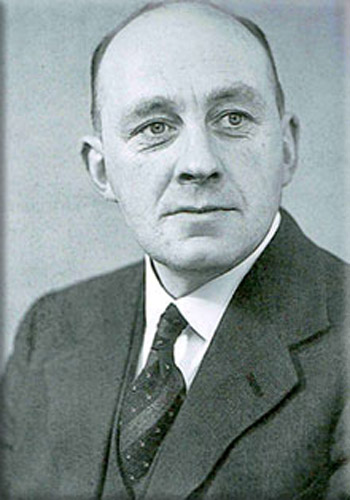
Everton won the FA Cup in 1933, with Dean becoming Everton's first-ever number 9 in the 3–0 final win against Manchester City. In this match, numbers were worn for the first time. The number 9 would become synonymous with commanding and high-scoring strikers at domestic and international level football, something Dean embodied.
He played his last match for Everton on 11 December 1937. Dean died at a Merseyside derby at Goodison Park in 1980, leaving behind a legacy of 383 goals in 433 matches overall.
In the 1938–39 season, Everton, with Joe Mercer, T. G. Jones and Tommy Lawton won the Football League Championship again. Lawton scored 34 goals during the season at the age of 19. The outbreak of World War II interrupted the players' careers for six years, bringing a halt to a team which otherwise may have achieved much more.
The 1940s–50s: the barren years
Although the 1990s have been regarded as a poor decade, this era was worse. The great 1939 championship-winning team was quickly split up in 1946. Tommy Lawton was sold to Chelsea, Joe Mercer disagreed with the manager Theo Kelly and was sold to Arsenal, and they tried to sell T. G. Jones to A.S. Roma. Soon only Ted Sagar was left.
Under the management of the uninspired and under-financed Cliff Britton, Everton were relegated after the 1950–51 season for only the second time in their history to the Second Division. This time it took three seasons before Everton were promoted in 1954 as the runners-up. The final match of the season decided promotion when Everton beat Oldham away 4-0.
The era nevertheless had some notable players such as Dave Hickson and Bobby Collins. Memorable matches included ending Manchester United's long unbeaten run at Old Trafford with a 5-2 win in 1956.
Everton did reach the FA Cup semi-finals twice, in 1950 losing to Liverpool and 1953, losing to Bolton 4-3.
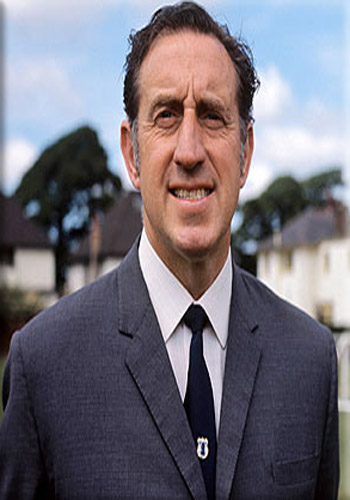
Harry Catterick Era (1961–1974)
The 1960s is regarded by many fans as the golden era of Everton Football Club. During this period they won the League Championship and Charity Shield twice (1963 and 1970 for both), and FA Cup once (1966). After the barren period of the 1950s, Harry Catterick took charge of the Everton in 1961. The team were soon to be dubbed the "School of Science" after their methodical approach in the tradition of the Everton team in the 1920s who were first given this name. Their football was inventive and flowing similar to Tottenham's "Push and Run" style. In Catterick's first full season as manager Everton conceded fewer goals than any other team and finished fourth.
Champions
The following season, the Toffees lost just six of their 42 matches and took the title, Everton's sixth. The striking partnership of Roy Vernon and the "Golden Vision" Alex Young scoring 46 goals between them (the last time two Everton players have scored more than 20 goals each in one season). Other notable players included Billy Bingham, Jimmy Gabriel, Derek Temple, Bobby Collins and Brian Labone.
Trebilcock and Temple
In 1966, the same year the English international team won the World Cup, Everton took home the FA Cup in a classic, after overturning a two-goal deficit against Sheffield Wednesday in the final to win 3-2. Everton reached final again in 1968, but were unable to overcome West Bromwich Albion at Wembley. The following year Everton did progress to the semi-finals, losing 1-0 to Manchester City.
The "Holy Trinity"
A year later in the 1969–70 season, Everton won the Championship again thanks in part to the scoring sensation of Joe Royle, who would later manage the club to FA Cup success in 1995. The success of the team could be seen from the number of points won (one short of the record) and nine clear of Leeds United. The team won the league in style, playing what was virtually a form of Total Football orchestrated by the "Holy Trinity" midfield of Howard Kendall, Alan Ball and Colin Harvey. With Labone at centre-half and club captain and Royle up front, this is regarded by many fans as the club's finest side ever.
Harry Catterick's team of 1969–70 seemed destined for greatness but declined quickly. In 1970–71 Everton did not recapture their league form but did progress on two cup fronts. For only the second time, Everton played in the European Cup reaching the Quarter-finals but were knocked out by Greek side Panathinaikos on the away goals rule. The previous weekend Everton took on neighbours Liverpool in the FA Cup semi final and lost 2-1.
Everton finished 14th in 1971, and 15th, 17th and 7th in the following seasons. The stress of an under-performing team was said to be a factor in Harry Catterick's poor health and eventual resignation in 1974.
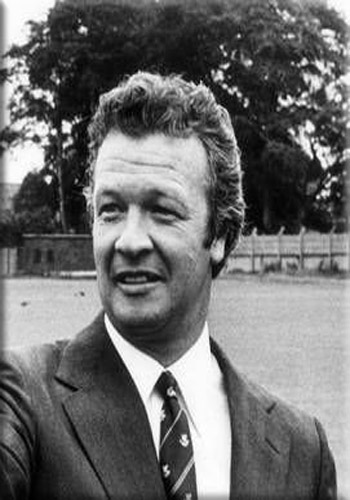
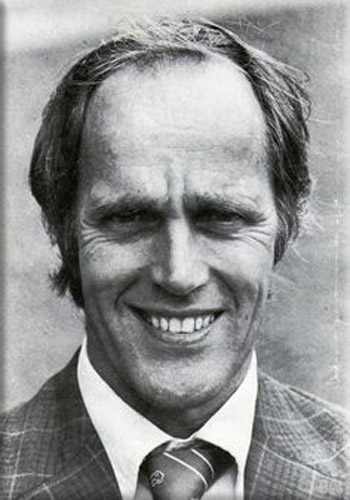
Billy Bingham and Gordon Lee Era (1974–1981)
Everton were on course to win the Championship again in the 1974–75 season under Billy Bingham (some bookmakers had even stopped taking bets at Easter) but some surprising losses to lowly opposition ended the challenge and they finished 4th. After two relatively poor seasons (11th and 9th), Bingham left in 1977.
During the interregnum, Everton reached their first League Cup final, with Aston Villa, and the FA Cup Semi final, against Liverpool. In the League Cup Everton and Aston Villa drew the final at Wembley and drew the replay at Hillsborough, before Everton lost late in extra time of the second replay at Old Trafford. The FA Cup Semi final was drawn 2-2 but the match will forever be remembered for the goal by Bryan Hamilton that was disallowed. Everton lost the replay 3-0.
Under Gordon Lee Everton finished third in 1977–78 (Bob Latchford topped the first division scoring chart with 30 goals), and 4th in 1978–79, after yet again looking serious title contenders for much of these seasons. However, the expectations were high given the success of Liverpool across the park, and finishes of 19th in 1979–80 and 15th in 1980–81, too close to the relegation zone for comfort, led to Lee's departure. Everton did reach the FA Cup Semi final in 1980 drawing with Second Division West Ham but lost the replay.
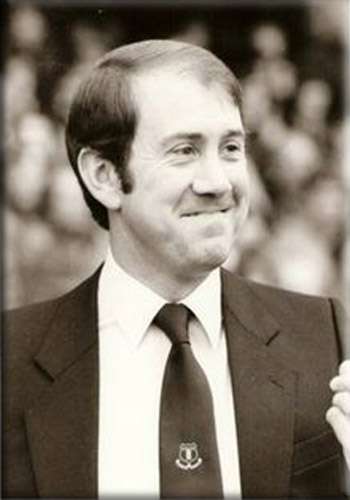
Howard Kendall Era (1981–1987)
Honours Won : FA Cup (1984), Charity Shield (1984), European Cup Winners Cup (1985), League Championship (1985), Charity Shield (1985), Charity Shield Shared (1986) League Championship (1987).
Runner-Up : Milk Cup (1984), FA Cup (1985), First Division (1986), FA Cup (1986)
Former Everton player Howard Kendall returned to the club as manager for the 1981–82 season, having won promotion from the Third Division with Blackburn Rovers and taken them within a whisker of a second successive promotion. Kendall's reign got off to a promising start with a 3-1 win over Birmingham City on the opening day of the season, and they finished eighth in the First Division. Their steady progress continued into 1982–83, as they finished seventh and only narrowly missed out on a UEFA Cup place. The only real letdown that season was a 5-0 home defeat by Liverpool on 6 November 1982.
During the first three seasons after his appointment as Everton manager, Kendall brought through younger players like Neville Southall, Gary Stevens, Derek Mountfield, Peter Reid, Kevin Sheedy and Trevor Steven with Kevin Ratcliffe and Graeme Sharp already at the club. Other players would be added but the most significant purchase late in 1983 was Andy Gray. Everton hoped to bring in some success having been massively overshadowed since the early 1970s by neighbouring Liverpool.
1983–84 was a trying season in the league, with Everton being in the bottom half of the First Division for much of the season and fans making continued calls for Howard Kendall to be sacked, but a good run of form in the final weeks of the season saw Everton achieve a seventh place finish once again. Everton were however progressing on two cup fronts. Reaching their second League Cup final, now known as the Milk Cup, the Blues drew 0-0 with Liverpool at Wembley, but eventually lost the replay. The FA Cup though was the silver lining, with Everton winning the final 2-0 against Watford to end a 14-year trophy drought. This was the fourth time Everton had won the 'Cup.
1984–85
The following season was to be one of Everton's finest. Despite a less than convincing start, this young Everton team began to flourish.
Everton won their eighth league title with four matches to spare. Once again though, Everton were progressing on two cup fronts. In Europe, Everton reached their first European final after defeating German giants Bayern Munich 3-1 at Goodison, in the European Cup Winners' Cup, after the first leg ended 0-0. The match is regarded as one of the most memorable in the club's history. The final against Rapid Vienna was also won 3-1, as Everton clinched their first-ever European trophy.
In the FA Cup, Everton reached their second successive FA Cup Final. Having already won the league, and having just won the Cup Winners Cup three days earlier, Everton set their minds on a treble. At Wembley, in the final, a tired Everton lost1-0 to Manchester United. Had they not lost, Everton would have joined Liverpool as only the second English team to win three major trophies in one season.
The 1984–85 Cup Winners' Cup campaign was not without its controversy. In a tie with Fortuna Sittard of the Netherlands, an Everton fan streaked on the pitch and was arrested when trying to climb back over the security fencing into the stands. This was one of many high profile pitch invasions by fans of English clubs at home and abroad around this time.
Fans contend that the 1980s Everton team could have gone on to win even more European silverware after their 1985 Cup Winners' Cup success had it not been for the banning of all English clubs from continental competitions by UEFA after the Heysel Stadium disaster (involving, in dark irony, Liverpool fans).
The 1985 close season saw the acquisition of 24-year-old striker Gary Lineker from Leicester City, with Lineker's arrival sparking the controversial departure of the hugely popular Andy Gray, who returned to Aston Villa.
Double runners up
1985–86, even without European action, would be another exciting season for Everton. By the end of September, it looked as though Manchester United would be champions of the First Division after winning the first 10 games of the campaign, while Everton were in fifth place and stood 13 points adrift of Manchester United and also had Liverpool, Chelsea and Newcastle United above them. However, United's excellent form gradually tailed off and Everton went top of the league on 1 February 1986 thanks to a 1-0 win at home to Tottenham Hotspur.
After this Everton looked on course to retain the title for most of the remaining season, although Liverpool and surprise contenders West Ham kept on Everton's heels for the following months. However, failure to beat Nottingham Forest followed by a shock 1-0 defeat to Division One newcomers Oxford United on 30 April resulted in Everton being unseated from the top spot by Liverpool, with only three games remaining. Unfortunately, their defence of the title was ended on 3 May 1986 as Liverpool's last league game of the season left the title out of Everton's reach, despite Everton crushing Southampton 6-1 at Goodison Park on the same day.
However, Everton won the race for second place by defeating fellow contenders West Ham United 3-1 on the final day of the league season. On 10 May 1986, they took on Liverpool in the first all-Merseyside FA Cup final. A first-half goal by Gary Lineker, his 40th of the season, suggested that the FA Cup would be heading to the blue half of Merseyside, but two goals form Ian Rush and a goal from Craig Johnston saw Liverpool win the trophy to complete the double, while Everton were left with nothing.
Had UEFA decided to lift the ban on English teams in European competitions at the end of that season (though the ban on all clubs was indefinite, it was reviewed at the end of every season), then Everton would have entered the Cup Winners' Cup, but UEFA voted for the ban to continue for at least another season and so there would be no European action for English clubs for the second season running.
The 1986 close season saw Everton sell leading goalscorer Gary Lineker to FC Barcelona of Spain, and the arrival of defender Dave Watson from Norwich City, while midfielder Adrian Heath switched to the role of Graeme Sharp's strike partner.
Champions again
The 1986–87 campaign began in a familiar fashion, with Everton and Liverpool being firmly among the contenders, though this time there some unlikely other teams also in contention, including Norwich City and Coventry City. By Christmas, Everton were fourth in the league (level with third placed Liverpool) and a point behind second-placed Nottingham Forest, while a resurgent Arsenal were six points ahead of them at the top of the league. However, a 3-1 win over Coventry City on 7 February 1987 sent them to top of the league, and they clinched the league title on 4 May 1987 with a 1-0 win over Norwich City at Carrow Road.
The European ban on English clubs continued, so Everton would not be able to compete in the European Cup in 1987–88.
During the 1987 close season, Howard Kendall defected to Spain to become coach of Athletic Bilbao, and was replaced as manager at Everton by his former assistant Colin Harvey.
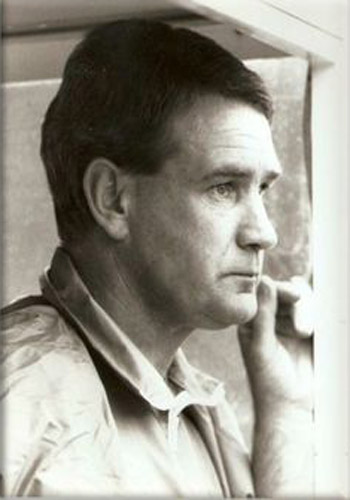
Colin Harvey era (1987–1990)
Honours won : Charity Shield (1987)
Runner-up : Simod Cup (1989), FA Cup (1989)
Colin Harvey's first season as manager brought a fourth-place finish, but no European qualification due to the UEFA ban on English clubs in European competitions. During the 1988 close season Everton became the first English club to buy a player for £2 million when they signed 23-year-old striker Tony Cottee from West Ham United. Despite the new arrival scoring a hat-trick on his debut against Newcastle United and going on to be one of the most highly rated frontmen to wear an Everton shirt, Everton's league fortunes declined in 1988–89 as they finished eighth in the league. Everton did return to Wembley twice, in April for the Full Members Cup final only to lose out to Nottingham Forest and in May in the FA Cup final, losing 3-2 to Liverpool in extra-time, in a game somewhat overshadowed by the Hillsborough Disaster in Liverpool's semi-final.
1989–90 began well for Everton, who led the league for two weeks in late autumn. There was extra incentive for title glory this season, as UEFA had vowed to lift the ban on English clubs in European competitions for the following season provided England fans behaved well at the World Cup. However, Everton never regained the lead of the league that they had lost in early November, and finished sixth in the final table.
On 31 October 1990, Everton occupied the 18th of 20 places in the First Division. Only the bottom two clubs would be going down this season, as the top flight would be expanding to 22 clubs for 1991–92. However, it was still Everton's worst start to a league season, and manager Colin Harvey paid for these shortcomings with his job.
The Return of Howard Kendall (1990–1993)
Runner-Up : Zenith Data Systems Cup (1991)
Everton had struggled in the first few months of the 1990–91 season and manager Colin Harvey was sacked. The club sought to bring back Howard Kendall for a second time as manager, and in November Kendall left Manchester City and returned to Everton, along with Harvey who became assistant manager. Things had looked liked they had improved when Everton returned to Wembley for the Zenith Data Systems Cup final, only to lose 4-1 in extra time against Crystal Palace. Action in the First Division saw Everton climb out of the relegation zone to see Kendall guide Everton to a ninth place finish.
The 1991 close season saw the departure of Everton hero Graeme Sharp but the attack was bolstered by Peter Beardsley who was signed from Liverpool and Mo Johnston from Glasgow Rangers.
Despite these changes to the squad, Everton continued to decline in 1991–92, finishing 12th – their lowest finish for more than a decade. 1992–93 was the first year of the new FA Premier League, which took over from the Football League First Division as the highest division of English football. However Everton finished 13th and the pressure grew upon Howard Kendall.
The opening stages of the 1993–94 season looked to be the turning point for Howard Kendall in his second spell as Everton manager, as they topped the Premier League after winning their opening three games. However, a dismal run of form followed over the next few weeks, and Kendall walked out on Everton in early December after they had plummeted down the league to occupy a mid table position. This was followed by a dismal run of form under caretaker manager Jimmy Gabriel, which saw Everton drop to the fringes of the relegation battle by mid-January.
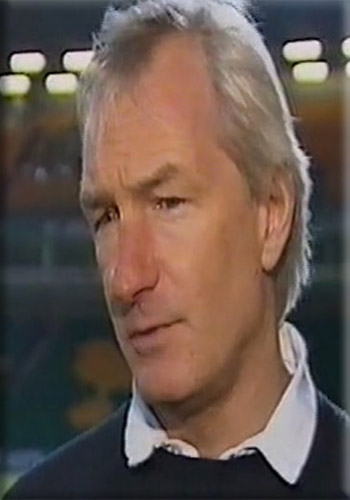
Mike Walker Era (1994)
In January 1994 Everton found a successor to Howard Kendall when they recruited Mike Walker from a Norwich City side that had recently finished third in the Premier League and eliminated Bayern Munich from the UEFA Cup. Everton would later be fined £75,000 by the Premier League for "indirectly inducing" Walker to leave Norwich. He was now faced with a challenge of saving Everton from relegation from a top flight which they had so far been members of for 40 successive seasons and been champions of just seven years earlier. Results under the new manager were initially good, but the team stumbled again in March and hit another horrible run of form, and this combined with a freak set of results on the penultimate matchday dumped Everton into the last relegation spot, leaving the club in the unthinkable position of being relegated unless they not only won their last match, but other results went their way as well.
The "Great Escape"
On the final day of the season Everton needed to beat Wimbledon at Goodison Park in order to stay up. Wimbledon took a 2–0 lead, but Everton pulled off a dramatic escape act thanks to a first half penalty from Graham Stuart, a second half goal from Barry Horne and a late winner again from Stuart to win 3–2 and help send Sheffield United and Oldham Athletic down with already-relegated Swindon Town. Everton made a poor start to the 1994–95 season and were bottom of the league after 14 games, having won just once (and even then not until their 13th match), and Walker was sacked in November 1994.

Joe Royle Era (1994–1997)
Honours Won : FA Cup (1995), Charity Shield (1995)
The "Dogs of War"
Within days of Walker's sacking, former Everton player Joe Royle had returned to the club as manager after 12 years in charge of Oldham Athletic. His key priority was to save Everton from relegation. He made a few changes to the squad in his first few months as manager, including making striker Duncan Ferguson's loan move permanent for a club record £4million. Everton confirmed their Premier League survival in the penultimate game of the season when they won 1-0 at already-relegated Ipswich Town.
But the biggest success of Everton's season came on 20 May 1995, when a Paul Rideout goal gave them a 1-0 win over Manchester United in the FA Cup final. The brilliant goalkeeping of Neville Southall also played a crucial part in Everton's first major trophy win for eight years; he made several thrilling saves in the game, including two late shots from 20-year-old Manchester United forward Paul Scholes.
Royle bolstered Everton's squad for the 1995–96 season, with a club record £5million move for Manchester United's unsettled Ukrainian winger Andrei Kanchelskis. He was determined to build on the FA Cup glory with a good run in the UEFA Cup Winners' Cup however runs in the cup competitions were short lived. Everton's league form was vastly improved as they finished sixth and were narrowly pipped to a UEFA Cup place by Arsenal on the final day of the season. It had been a great season for Kanchelskis though, as he scored 16 goals and continued to live up to his reputation as the finest right-winger in the Premier League. However, he defected to Fiorentina halfway through the next season. Everton slowly fell apart without Kanchelskis and manager Royle stepped down as manager on 27 March 1997 over a disagreement on transfers and with a relegation battle creeping upon the club. Veteran defender and captain Dave Watson took over as caretaker until the end of the season, helping confirm Everton's survival, but he did not want the job permanently and the hunt was now on for a new manager.
The Third Howard Kendall Era (1997–98)
After the end of the 1996–97 season, Everton approached Howard Kendall (by now at Sheffield United) following rejections from Bobby Robson and Andy Gray about a third spell as the club's manager. Kendall returned and there was much hype as the new season began about whether Kendall could still work his old magic and re-establish Everton as one of England's top playing sides. However, the 1997–98 campaign was a difficult one. As in 1994, Everton's survival was not assured until the last game of the season and only achieving survival on goal difference at the expense of Bolton Wanderers. Off the field, the club was in a major financial crisis at this time which would not be resolved until 1999.
Kendall's third spell as manager ended in June 1998 when he was sacked, and it seemed likely that chairman Peter Johnson would turn to Manchester United assistant manager Brian Kidd as his successor, but the job went to Walter Smith instead.
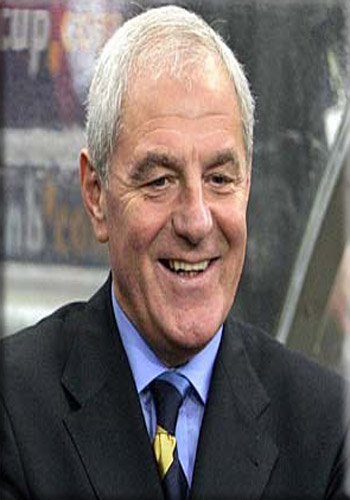
Walter Smith Era (1998–2002)
Successful former Rangers manager Walter Smith took over from Kendall in the summer of 1998 and big things were expected along with some high profile signings but his first season saw another relegation battle, and only a late run of four wins from their final six games saw them earn safety a 14th place finish. During the 1998–99 season striker Duncan Ferguson was sold to Newcastle United without Smith's knowledge.
The resulting outrage from supporters regarding the manner of the sale lead to chairman Peter Johnson stepping down from his post.
Theatrical producer Bill Kenwright bought control of the club and installed Philip Carter as the new chairman. Smith's chances of success were hampered by continuing financial constraints which had also contributed to the club's decline in previous years. 1999–2000 proved to be a better campaign, and the club looked to have an outside chance of qualifying for the UEFA Cup for much of the season.
In the reverse of the previous year though, Everton fell apart in the final months of the campaign, claiming just two victories from their last twelve games and finishing in 13th, just one place higher than the previous year. 2000–01 saw a major step back however, and the club once again fell into a relegation battle, not helped by long-term injuries to several key players.
In March 2000 American cable television provider NTL approached the club with a view to purchasing a 9.9% stake in the club. Everton expected to announce a deal before the beginning of the 2000–01 season, but by October 2000 any chance of an agreement had disappeared leaving Everton with financial difficulties and forced to sell first team players, including Youth Academy products Francis Jeffers and Michael Ball, to balance the books - the board had already spent £18.4 million on purchasing new players including bringing back Duncan Ferguson, on the basis that an agreement was in place.
Around the same time Paul Gregg had been negotiating a deal with United News and Media but this never came to fruition.
The Everton board finally ran out of patience with Smith and he was sacked in March 2002 after an FA Cup exit at Middlesbrough, with Everton still in real danger of relegation.

David Moyes Era (2002–2013)
Runner-Up : FA Cup (2009)
In March 2002 the board turned to promising young Preston manager David Moyes with the task of moving Everton forward after years of underachievement, and he was able to steer the club to safety in the last few games of the season, finishing 15th. In Moyes's first full season in charge Everton finished seventh in the Premiership and just missed out on a UEFA Cup place, in a campaign which was dominated by the emergence of brilliant young striker Wayne Rooney, who came to national prominence with a spectacular last-minute winner against league champions Arsenal, becoming the youngest English league goalscorer ever and Everton's youngest ever scorer, and consigning the champions to their first league defeat for almost a year.
2002–03 was Everton's best season since the sixth-place finish of 1995–96 and for a while it had even looked like they would qualify for the Champions League. In the FA Cup the Toffees were on the receiving end of a giant-killing, away to Shrewsbury Town, who were managed by former Everton captain Kevin Ratcliffe and were just four months away from being relegated from the Football League. The following season's league form was a stark contrast, with the club finishing 17th and accumulating the lowest points total in the club's history.
Wayne Rooney handed in a transfer request and was sold to Manchester United in August 2004 for a fee of £23million, with a potential to rise to £30million due to bonus payments for league positions, trophies, international caps and 25% excess sell on fees. Despite the loss of Rooney Everton's 2004–05 was much more successful and finished fourth in the table, their highest position since 1988, achieving Champions League qualification, ahead of rivals Liverpool. They played some of their finest football for years, thanks greatly to the 4-5-1 tactic of Moyes and the form of Danish midfielder Thomas Gravesen, who was sold to Real Madrid midway through the season.
Despite the euphoria of the previous season and the Champions League qualification, Everton started the 2005–06 badly, with their Champions League campaign ending in defeat by Villarreal in the qualifying stages, after referee Pierluigi Collina controversially disallowed an important Everton goal. After being demoted to the UEFA Cup, they were knocked out by Dinamo Bucharest, who thrashed the English side 5–1 in Romania.
After occupying the Premier League relegation zone throughout October 2005, Everton stopped Chelsea's nine match winning run with a 1-1 draw to spark a short revival that saw the team finally start to get regular results to put much needed points on the board. However, this was followed by another dismal run including several 4-0 defeats to sides in the bottom half of the table and a one sided derby match. A 1-0 win at Sunderland on New Year's Eve started a run of five straight Premiership wins and six matches unbeaten including victory against Arsenal- the club's best run of results since the Premiership began which hauled the team away from the relegation zone, and made a top half finish or even Europe a real possibility. This was not to be as the team remained as inconsistent as ever and a disappointing draw on the last day meant an 11th place finish instead of moving into the top half. Inconsistency and a shortage of goals let Everton down in 2005–06, and ended their hopes of another European campaign.
Everton began the 2006–07 season well, including a first league win at White Hart Lane in twenty years, followed by a 3-0 win over Liverpool. The club's transfer record was broken with the signing of Andrew Johnson from Crystal Palace. At the end of the season Everton were in 6th place and qualified for the following seasons UEFA Cup competition. During the summer of 2007, the club announced the acquisition of a professional basketball team, called the Everton Tigers, and were entered into the British Basketball League as one of three expansion franchises for the 2007–08 season.
In 2007–08 Everton again broke their transfer record with the signing of Yakubu for £11.25 million from Middlesbrough. The club reached the group stage of the UEFA Cup, where they went on to win all of their games, including against the eventual winners Zenit St Petersburg. Having successfully negotiated the next round Everton were knocked out in the last 16 by Fiorentina on penalties. In the Carling Cup Everton reached the semi-final for the first time in 20 years, losing to Chelsea. Everton spent much of the season in the top four of the league, but were eventually overtaken by Liverpool and finished 5th, again qualifying for the UEFA Cup.
The following summer was one of some turmoil for Everton as their failure to gain Government acceptance for their proposed stadium move to Kirkby, the departure of Chief Executive Keith Wyness and the seeming reluctance of Moyes to sign a new contract increased the gloom amongst supporters. In the last week of the transfer window the club transfer record was broken with the signing of Marouane Fellaini for £15 million from Standard Liege. Everton failed to qualify for the UEFA Cup group stages as they were eliminated by Liege, with Fellaini ineligible to play against his former team.
Moyes did eventually sign a new five-year contract with the club, and with it fortunes began to turn. A strong run in November and December (8 wins and 2 draws in 12 league games) propelled the club to the upper reaches of the league table and raised hopes for another top 6 finish.
In early February, Everton played Liverpool 3 times in quick succession, once in the league (a 1-1 draw at Anfield) and twice in the FA Cup, with Everton ultimately proving victorious in the replay at Goodison Park.
Season ending injuries to Yakubu, Mikel Arteta and Phil Jagielka did not halt Everton's progress and the end of the season saw the team finish in 5th place again in the league on the back of only 3 defeats in 29 matches, to qualify for the following seasons Europa League competition. Everton did reach their First FA Cup final since 1995 after knocking out Manchester United on penalties in the semi final at Wembley, but were overcome by Chelsea and lost 2-1.
The 2009–10 season began with the club losing their opening 2 home games, including a 6-1 home defeat at the hands of Arsenal and after a long period of speculation Joleon Lescott was sold to Manchester City for £22 million. The club qualified for the group stages of the Europa League, but continued to perform poorly in the league. League results improved in December 2009, but Everton were knocked out of Europe over two legs by Sporting CP. At the end of March they set a club record in the Premier League with 7 consecutive home wins, which included victories over title chasers Chelsea and Manchester United. Everton finished the season in eighth place, just one place and two points adrift of neighbours Liverpool and a place in the UEFA Europa League for the following season. It was only the second out of six seasons where the Toffees failed to achieve European qualification.
The 2010–11 season began with Everton in poor form. They failed to win a league game until October, and had been knocked out of the League Cup by Brentford. However, by the end of that month the situation had stabilised and they were 7th in the table. Patchy league form ensued, through to the new year, however a highlight was an FA Cup 5th Round win at Chelsea. A run of only 3 defeats in 18 league games ensured that the club would have its seemingly customary strong finish to the season and by mid April the club was in 7th position, 1 point behind Liverpool. Everton would go on to finish 7th that season with 54 points, being everton's lowest points tally from 5 years.
2011–2012 season saw Everton get off to their now customary sluggish start, and were struggling in 16th place at the beginning of November. The turn of the year, and the signing of Nikica Jelavic from Rangers, saw fortunes improve dramatically, however. The club embarked on a sequence of only 2 defeats in 17 League and Cup matches, including wins over Manchester City, Chelsea and Tottenham. Everton also found themselves in an all-Merseyside FA Cup Semi Final for the right to play Tottenham or Chelsea in the final at Wembley. After taking the lead through a Jelavic goal, Everton were pegged back in the second half and conceded a late winner to end their Cup run for the season. This reverse not withstanding, it was Jelavic's goals (9 in 13 appearances since his transfer) that helped secure only 4 defeats in the last 24 league games, and a 7th place finish, ahead of Liverpool for the first time in 8 seasons.
Everton started the 2012–13 season strongly, losing only 1 of their first 11 league games by the middle of November, and if the previous seasons games were taken into account, they had lost only 3 of the previous 29 league games since January. A hotly contested derby match at Goodison ended in a 2-2 draw, with Everton fighting back from 2 goals down. By the start of the new year, Everton had consolidated their position as genuine Champions League place contenders sitting in 5th position, having lost only 3 of the first 24 league matches of the season. Form stumbled somewhat post-Christmas winning only 1 of 6 league matches between January and February, hampering their Champions League objective. The club reached the quarter finals of the F.A. Cup, and appeared to be well positioned for a 3rd semi-final in the past 5 seasons, however they were surprised by Wigan Athletic at home. League form improved after this reverse, however, and a run of 3 successive victories, including a home win against champions Manchester City, maintained the club's challenge for European qualification.
However, extremely strong finishes by both Tottenham and Arsenal meant that Everton were forced out of the European places, and had to settle for 6th position, the consolation being finishing above Liverpool for the second season in succession.
The week following the Merseyside derby saw Moyes announce he was leaving the club at the end of his contract, to take up the position of manager of Manchester United after Sir Alex Ferguson's retirement.
Moyes' legacy was a strong core of players, who overachieved slightly within the confines of the financial structures in place at Everton. He took over at a difficult time for the club, who had flirted with relegation for several of the previous seasons prior to his arrival. However, the stability brought was balanced by a lack of genuine success, with a poor away record at the top sides, a mediocre record when competing in European competition and no silverware in any of the 11 seasons he was in charge.
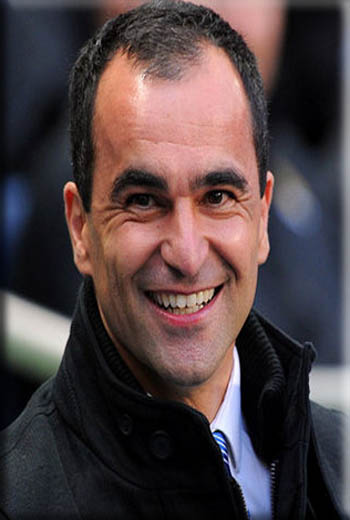
Roberto Martínez Era (2013-2016)
Wigan Athletic manager Roberto Martínez was named as manager on a four-year deal in June 2013, after a search that took the club several weeks to resolve.
Martínez made 7 acquisitions prior to the end of the transfer window, including 4 of his ex-Wigan players, Arouna Kone, Joel Robles, Antolin Alcaraz and James McCarthy. He was also able to engineer something of a coup by persuading Barcelona and Chelsea to allow highly rated youngsters Gerard Deulofeu and Romelu Lukaku to join the club on season-long loans.
Everton began the season well, with only 1 defeat in the opening 18 games, fewest in all 4 English divisions, and a record bettered only by Bayern Munich and AS Roma across Europe's top leagues. On 4 December 2013, Everton beat champions Manchester United, now managed by David Moyes, 1-0 at Old Trafford, their first win at the Manchester club's ground for 21 years.
At Christmas, the club sat in 5th place in the league, only 2 points from the top, very much in the thick of what promised to be the most closely fought Premier League title race in history.
The club managed to make the quarter-finals of the FA Cup where they were beaten by Arsenal at the Emirates Stadium. March and April brought 7 consecutive wins to cement their 5th place position, with realistic hopes of occupying a Champions League spot at the end of the season. However a surprising loss at home to Crystal Palace threatened to derail the challenge as the club entered the final 4 games of the season. Everton then defeated Manchester United 2-0 at Goodison Park, a match that proved to be ex-manager David Moyes last game in charge of the Manchester club as he was sacked 2 days later.
Any hope of gaining Champions League football ended with consecutive defeats to Southampton and eventual champions Manchester City. The club did however qualify for the following seasons Europa League competition, finishing in 5th with 72 points, 7 adrift of 4th placed Arsenal and their highest return since the Premier League's inception.
In July, the club broke their transfer record by signing Romelu Lukaku on a permanent transfer for £28 million. Bosnian midfielder Muhamed Besic was brought in for £4 million from Hungarian club Ferencváros. In a strange deal, Belgian under-18 striker David Henen was brought in on loan from Olympiacos, while the further signings of Christian Atsu (on loan from Chelsea) and Samuel Eto'o (on a free transfer) followed prior to the close of the transfer window.
Everton were off to a slow start in 2014, winning only one of their first seven league matches and conceding 16 goals in that span. As the season dragged on, Everton failed to win six in a row around New Year's Day and were sitting only a few points above relegation.
However, they performed strongly in the Europa League, winning their group in five matches. This included 4–1 and 0–2 wins over eventual German Bundesliga runner-ups Wolfsburg. Everton drew Swiss club Young Boys in the Round of 16 and defeated them 7–2 on aggregate, with Lukaku netting five goals. In the next round, Everton won 2–1 home to Dynamo Kyiv, but were eliminated with a 5–2 defeat in the return leg in Kiev. Lukaku's eight goals in nine Europa League matches would still give him the competition's Golden Boot.
Back in the league, Everton won six of their last ten matches, including a 3–0 win over Manchester United at Goodison Park, to push for 11th place at the end of the season on 47 points, 25 less than the previous season. The winter loan signing of Aaron Lennon from Tottenham helped the cause, while Eto'o left on a free for Sampdoria. This concluded a largely poor league performance, in which Lukaku led the team with ten goals.
Domestic cups also brought little success; the club won no cup matches. In the League Cup, Everton had lost out 3–0 to Swansea City in the third round, while in the FA Cup, Everton lost on penalties to West Ham United, also in the third round.
Despite the poor performance, Roberto Martínez was retained for the 2015–16 season. In the summer, Gerard Deulofeu was brought back in on a permanent deal for £6 million, while midfielder Tom Cleverley was brought in on a free transfer from Manchester United. Two South Americans joined the squad as well — Argentinian centre back Ramiro Funes Mori was purchased from River Plate for £9.5 million and Uruguayan striker Leandro Rodríguez was purchased for £500,000 from River Plate Montevideo. Aaron Lennon was also signed on a permanent deal from Spurs for a fee of £4.5 million.
Results still proved to be inconsistent however, with the New Year seeing Everton firmly ensconced in mid-table, although the Capital One Cup provided some solace, as the club reached the semi-finals where they would meet Manchester City; unfortunately, they would fall here. In the January window, Everton purchased striker Oumar Niasse from Lokomotiv Moscow for £13.5 million.
On 27 February, the club officially confirmed the arrival of a new 49.9% shareholder in Farhad Moshiri, an Iranian billionaire who had previously owned a stake in Arsenal. Moshiri would go on to increase his share holding to 68.6% in 2018 after buying shares from chairman Bill Kenwright, Jon Woods and Arthur Abercromby, and then in June 2019 would increase further to 77.2% after purchasing shares from the Grantchester family.
On the 12th May 2016, Martinez was sacked by the club in the face of vocal fan protests against his management in the wake of defeats to rivals Liverpool at Anfield, and in the semi-final of the FA Cup to Manchester United. The club ended the season in 11th position, for the second season running.

Ronald Koeman Era (2016-2017)
On 14 June 2016 Dutchman Ronald Koeman was appointed as manager under a three-year contract at reported £7 million per year.
Everton also announced Steve Walsh as Director of Football on 21st July of the same year.
Everton later announced the signing of Dutch goalkeeper Maarten Stekelenburg. From Aston Villa, centre midfielder Idrissa Gueye was the second signing of Koeman's first window. Young centre back John Stones was sold to Manchester City for 47.5 million pounds in August 2016 in a deal inadvertently breached on the UEFA website. Accordingly, the 31-year-old Ashley Williams was signed from Swansea City shortly after.
On 15 August, Everton signed winger Yannick Bolasie on a five-year deal from Crystal Palace. Everton also signed young forward Dominic Calvert-Lewin from Sheffield United, initially for the U23 squad. McGeady was loaned out to Preston North End in the championship for the season, while Everton acquired West Ham forward Enner Valencia on a season-long loan.
The club began the season confidently sitting in 3rd place after the first 4 games of the season. After a difficult period between September and December, which included a 5-0 defeat to Chelsea and a 1-0 defeat to Liverpool at home, the clubs form begun to turn for the better once again, and by April entering the final stretch of the season the club sat in 7th and looked very well positioned for a Europa League berth the following season.
Romelu Lukaku, who had been keeping the club waiting on his decision on whether or not to sign a new contract, had by April stormed to the top of the Premier League goal scoring charts with 24 goals.
The club finished 7th, thereby qualifying for the following seasons Europa League.
The summer was one of a large amount of turnover in playing staff with the sale of Romelu Lukaku to Manchester United for £90m, coupled with the return of Wayne Rooney, and the acquisitions of Davy Klaasen, Gylfi Sigurdsson, Jordan Pickford, Michael Keane, Cuco Martina, Sandro Ramirez and Nikola Vlasic.
However, despite spending over 150m in incoming transfers the club got off to a very poor start to the season, failing to win any of their Europa group stage games.
In October, an embarrassing 2-5 reverse at home to Arsenal left the club in the relegation zone prompting the board to act swiftly by removing Koeman from his position as manager 48 hours after that defeat, leaving u23 coach and former player David Unsworth in temporary charge of first team affairs.
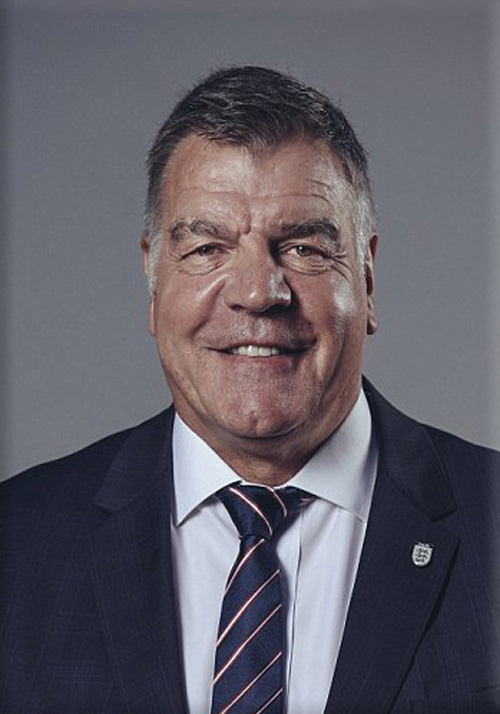
Sam Allardyce Era (2017-2018)
On Wednesday 29th November 2017, Everton hired Sam Allardyce as their new manager, on an 18 month contract, in turn allowing David Unsworth and his team to return to their duties prior to caretaking.
Everton had endured a difficult season, and were in 13th place at the time of Allardyce's arrival, with many fans concerned about the form of the team. Allardyce wasn't the popular choice among the fan base, but many accepted that his experience of steering clubs clear of relegation was a much needed factor in his appointment, while others were less impressed.
Allardyce appointed Sammy Lee and Craig Shakespeare as his coaching staff.
His first game in charge came two days later, when his side defeated Huddersfield Town in a 2–0 victory. He guided the "Toffees" to a seven-game unbeaten run at the start of his tenure, a spell which included five clean sheets.
Having steadied the defence, he stated that his next task was to bring in a consistent goalscorer, and in the January window, signed Cenk Tosun, a striker from Turkish club Besiktas, and Theo Walcott, an attacking forward from Arsenal.
Whilst Sam's style of football had acrued enough points for the club to feel more comfortable regarding league position, the overall play was deemed unentertaining by many, and many fans pointed to the statistics that showed whilst under Allardyce's management, Everton were ranked 20th for total shots, 19th for total shots on target, 16th for passing accuracy and 17th for shots faced in the Premier League.
However, on 17th May 2018, after guiding the club to 8th in the Premier League, the club announced that Allardyce was to leave, pending a managerial change in the summer.
Denise Barrett-Baxendale, who had in the same week replaced Robert Elstone as Everton chief executive, thanked Allardyce, adding: "Sam was brought in at a challenging time last season to provide us with some stability and we are grateful to him for doing that.
"However, we have made the decision that, as part of our longer-term plan, we will be appointing a new manager this summer and will be commencing this process immediately."
Everton Board Restructure
On the 15th May 2018, shortly before the departure of Sam Allardyce, Everton had announced a restructure of its Executive Leadership team and some major changes to its Board, which would become effective from the 1st June 2018. As stated above, Professor Denise Barrett-Baxendale had taken over from Robert Elstone as Everton’s Chief Executive Officer, after Elstone had left to take the role of Chief Executive of Super League.
Everton Chairman Bill Kenwright commented: “We are sad to see Robert leave the Club and wish him nothing but success. Robert has obviously been a passionate Evertonian since the day he first set foot here, but I have always known that his enduring love has been Rugby League. And we wish him well in his new role leading his favourite sport. Robert has run the Club wisely and well, throughout his time as our Chief Executive, and has become one of the most respected in the game. I will personally miss him for all the help he gave me, particularly on difficult transfer negotiations – and for the stability he brought to the Club throughout his time here. Thank you, Robert.
“My feelings about Denise are well known. She is a powerhouse and has my admiration and respect. The work that she has done for this Club, and particularly with our Community programme, has been monumental, and I’m more than pleased that she will help lead the Club to a new future. She has, and always has had, my total endorsement. I also congratulate Keith and Sasha on their new roles.”
Farhad Moshiri, Everton’s Major Shareholder, added: “I have been extremely impressed by the impact Denise has made in her time at Everton and Everton in the Community. She knows how to get results and I admire the way she goes about getting them. Her experience in football and business combined with her drive and ambition gives me complete confidence that she will be able to take all areas of the Club forward. I must also thank Robert for his valuable contribution to the Club over the past 13 years and wish him every success in his new role.”
There were also changes on the Club’s Board of Directors, with Dr Keith Harris becoming Deputy Chairman in place of Jon Woods who remained on the Board. Alexander Ryazantsev, would join the Executive Leadership team from 1st June and would take responsibility for the Club’s Financial and Commercial performance.
On 16th May 2018, Everton appointed Marcel Brands as their Director Of Football, ultimately replacing Steve Walsh. The Dutchman had established a reputation for developing players and building clubs, overseeing PSV Eindhoven’s charge to three Eredivisie titles in four seasons having previously been instrumental in transforming the fortunes of RKC Waalwijk and AZ Alkmaar. Brands would later join the Board Of Directors on the 17th January 2019.
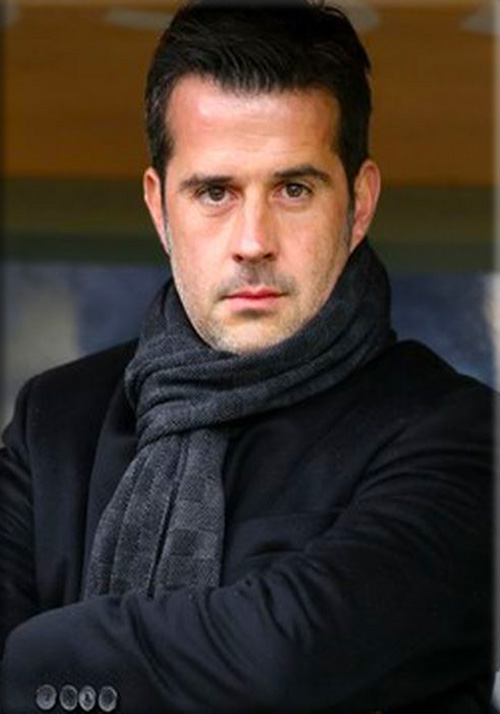

Marco Silva Era (2018-2019)
On Thursday 31st May 2018, Everton appointed Marco Silva as their next manager, on a 3 year contract.
Their persuit of Silva had not been without controversy, with Watford initially filing a complaint with the Premier League alleging Silva had been “tapped up” by Everton in November 2017, following the sacking of Ronald Koeman. Eventually the two clubs came to an amicable agreement, with Everton thought to have paid around £4 million in compensation.
Working closely with Marcel Brands, under the new structure in place at Everton, Silva's first job was to identify where the squad needed strengthening, and during the course of the summer, new arrivals at Everton included Richarlison, Digne, Bernard, Mina, Virgínia, and Gomes and Zouma on loan, with a considerable amount of players sold, or loaned out.
His first game in charge was an emphatic 22–0 win in a pre-season friendly over Austrian team ATV Irdning.
In his first full season, he led the Toffees to an 8th placed finish, with the club finishing the season on a high, after strong performances in the run in against the top 6 sides, which included a 4-0 victory over Manchester United. The season as a whole could be viewed in 3 sections, with a fairly good start, a very poor middle, and an extremely good final third, which left fans feeling positive, especially as the quality of football was seeing an upward curve.
Silva's assistant manager was replaced on the 7th June 2019 by Luis Boa Morte, after João Pedro Sousa had left Everton to become Famalicão’s new manager. On Thursday 5th December 2019, with Everton sitting in 18th place, the club announced that Silva had left, with coach Duncan Ferguson to act as caretaker.
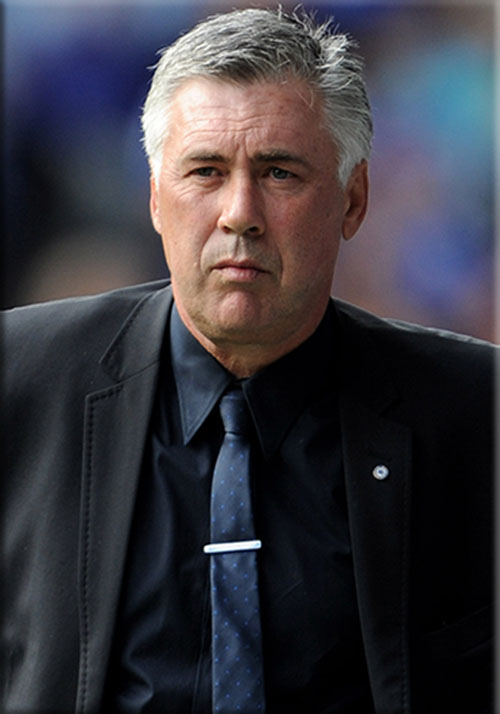
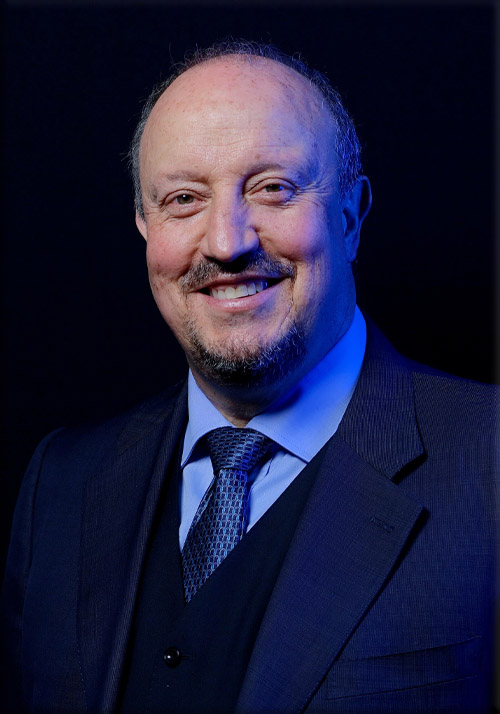
Carlo Ancelotti Era (2019-2021)
On 21st December 2019 Everton announced a 4 1/2 year contract had been accepted by new manager Carlo Ancelotti. When Ancelotti arrived, the club was sitting in 15th place. He eventually led the club to a 12th place finish for the 2019–20 season. In the 2020–21 season, Everton finished 10th under Ancelotti. Up until the 6th matchday of the season, the club held the top spot in the league, following four wins in a row, which could be credited to new signings James Rodríguez, Allan, and Abdoulaye Doucouré. At the winter break, the club was sitting in second place. However, Everton's form started to slip, and the club went through a five-match winless run in March and April, which eventually left the club out of the European places.
At the end of the season, Ancelotti left the club and returned to Real Madrid. The news came as a shock to any supporters, as the Italian had previously stated that he wanted to stay at the club until the Bramley-Moore Dock stadium opened. Although the club had a disappointing season, a notable highlight was winning the Merseyside derby at Anfield 2–0. This was the first time Everton had won at Anfield in 22 years, with the last win coming in September 1999; this was also the club's first Merseyside derby win since 2010.
Rafael Benitez Era (2021-2022)
Rafael Benitez was hired in June 2021, becoming the second manager to lead both Merseyside clubs. A strong first two months in charge had the club in fourth place in early October, but Everton slipped down the table and was hovering just outside the relegation places by the new year. Benitez was sacked after a January 15th loss at Norwich.

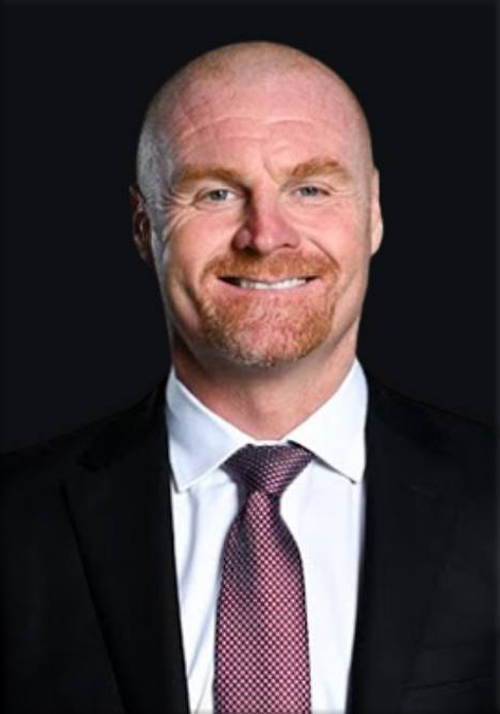
Frank Lampard Era (2022-2023)
Frank Lampard was hired on 31st January 2022. Everton was involved in a four-team relegation fight for the remainder of the season, and despite dipping into 18th place following an April loss at Burnley, home wins over Manchester United and Chelsea narrowly kept their heads above water. On 19th May, a late winner from Dominic Calvert-Lewin at home against Crystal Palace confirmed survival. A run of eight losses in nine matches wrapped around the World Cup break was enough for Moshiri to sack Lampard on 23th January 2023.
Sean Dyche Era (2023-Present)
Sean Dyche was announced as Everton Manager on 30th January 2023.





















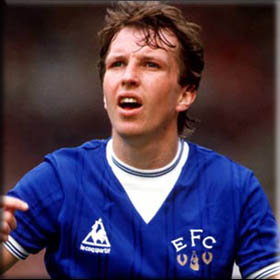
 Dave Watson - 1986 - 01
Dave Watson - 1986 - 01
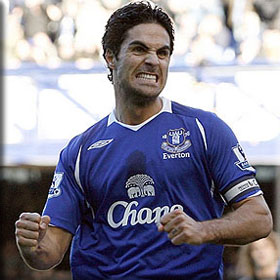 Mikel Arteta - 2005 - 11
Mikel Arteta - 2005 - 11
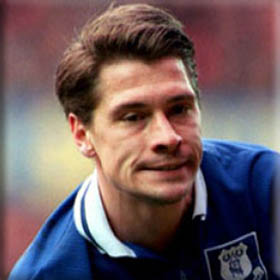 Tony Cottee - 1988 - 84
Tony Cottee - 1988 - 84
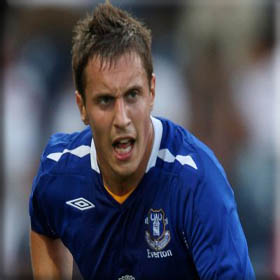
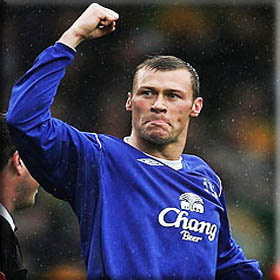
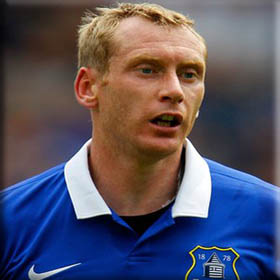
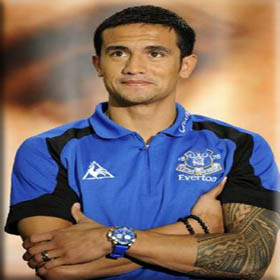
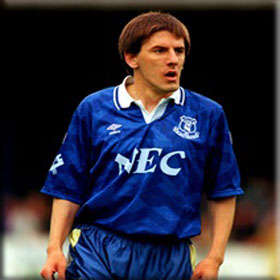 Peter Beardsley - 1991 - 93
Peter Beardsley - 1991 - 93
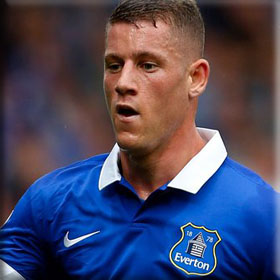
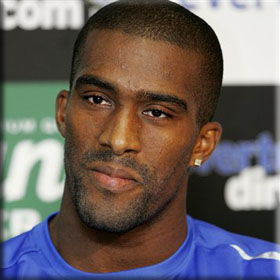

 Gary Lineker - 1985 - 86
Gary Lineker - 1985 - 86
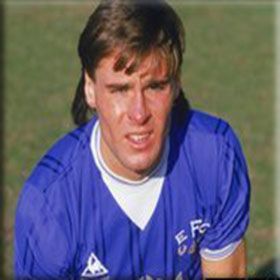 Pat Van Den Hauwe - 1984 - 89
Pat Van Den Hauwe - 1984 - 89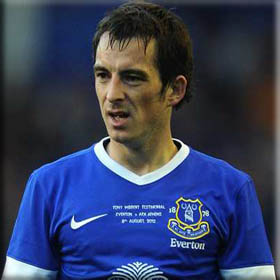
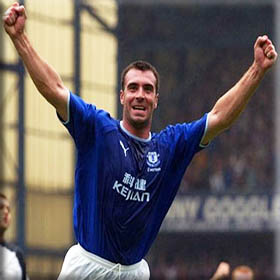
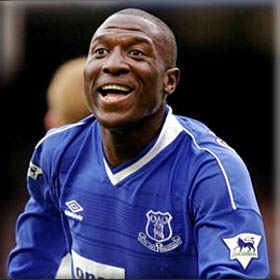 Kevin Campbell - 1995 - 05
Kevin Campbell - 1995 - 05
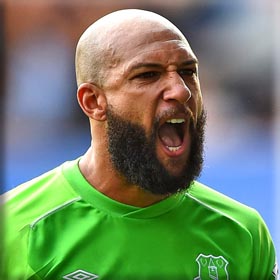
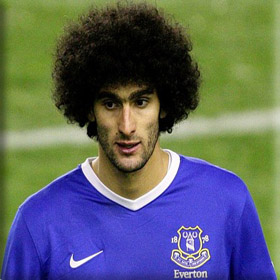 Marouane Fellaini - 2008 - 13
Marouane Fellaini - 2008 - 13
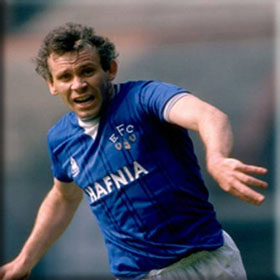 Peter Reid - 1982 - 89
Peter Reid - 1982 - 89

